Don't wanna be here? Send us removal request.
Text
St. Andrews Bay, South Georgia Island. Dec. 27, 2024. Part 5.
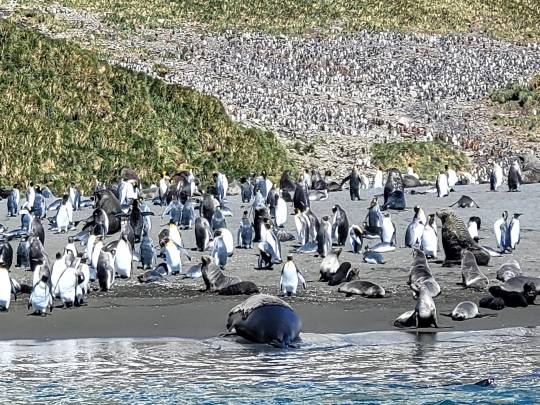
St. Andrews Bay has a King Penguin colony of 100,000 birds. They nest way up the hill as far as you can see. When you think of them traveling that distance, up hill, taking 3 inch steps. Then try and find their one chick to feed. It boggles the mind.
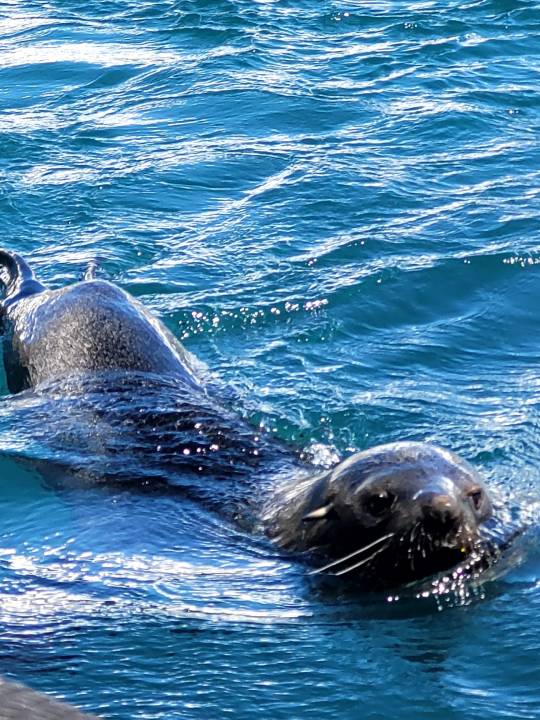
Here a friendly fur seal checks out our zodiac on our way to the beach.
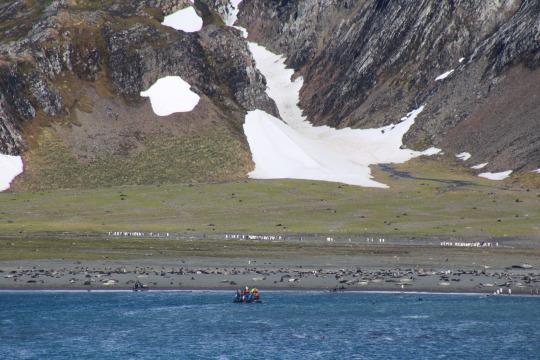
We landed to the far right side of the main colony. Even then it was problematic to stay 15 feet from the fur and elephant seals. The black dots way up the hill are fur seals.
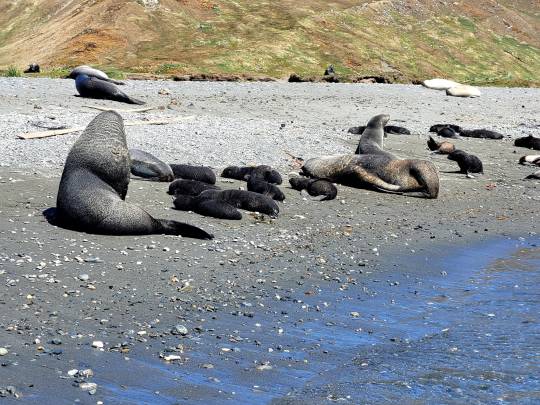
We make a successful wet landing. The Expedition guides had surveyed a path for us to follow. We are supposed to generally walk near the red flags they plant. Orange cones denote a dead seal. We have to stay 30 feet from the dead carcass. No complaints from me!
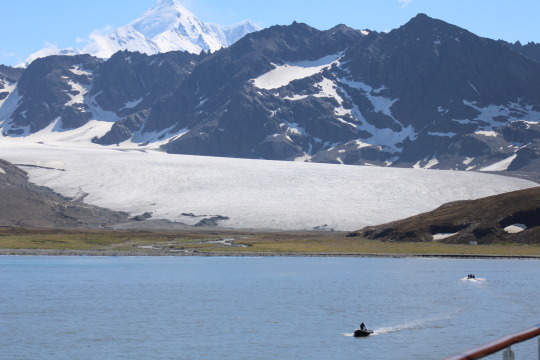
St. Andrews’s Bay is famous for the huge Penguin colony and the three glaciers that empty into the bay. David Attenborough has been here several times documenting the glacier retreating. During his first visit in the 60’s he could barely pass the glacier face on the beach. Now it has retreated back several miles.
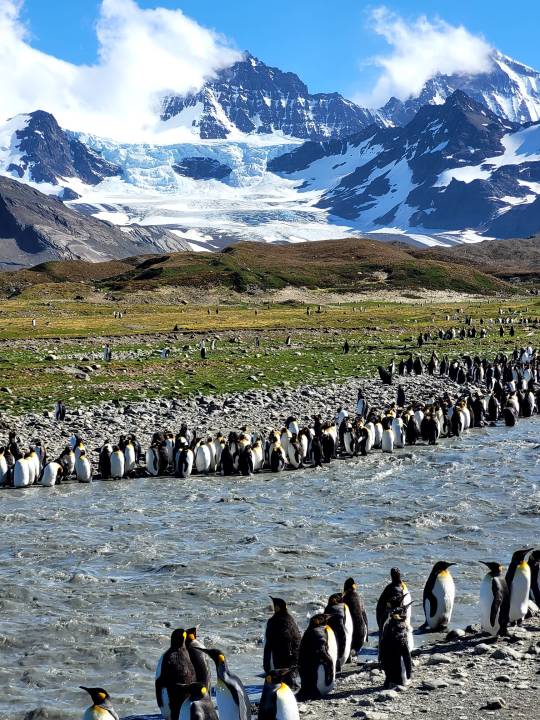
Glacial run off cuts the colony up. Most of these are juveniles and should stay out of the ice cold water.
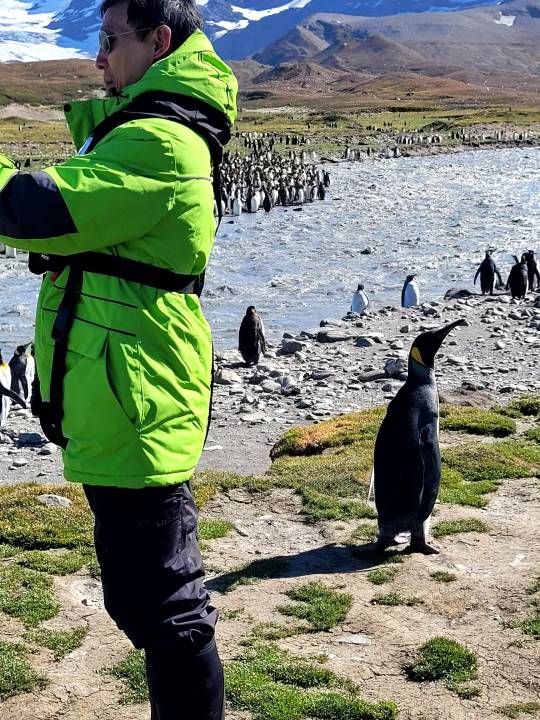
If you are not paying attention a King Penguin will walk right by you.
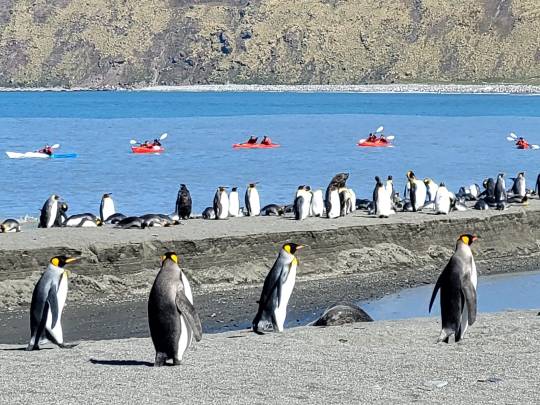
Here a group of kayakers from the ship pass down the shoreline. During one kayak trip, a fur seal jumped on the back of a kayak. Then looked over the shoulder of the guy paddling from the back of the kayak.
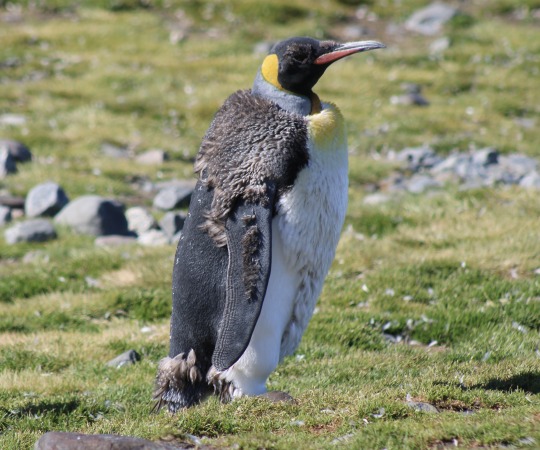
The juvenile King Penguins are even more comical looking during their molt.
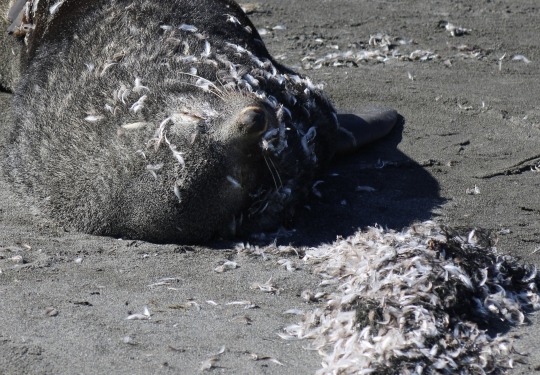
The white penguin feathers fly around like a snow storm. Here is an oblivious fur seal taking a nap.
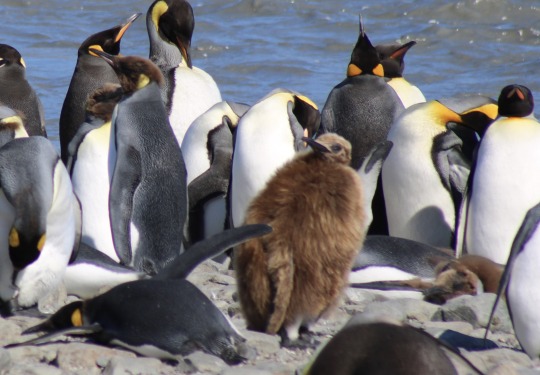
The brown chicks are really young King Penguins. This guy was on a small island in the glacial stream. It had a cold swim to get here.
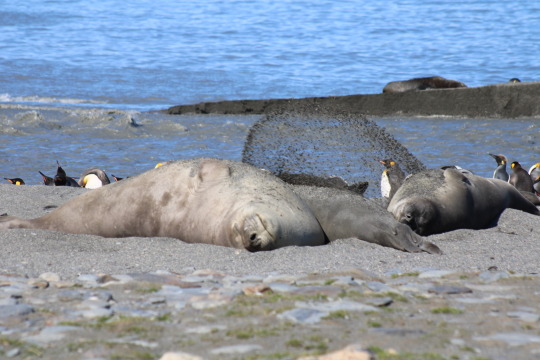
Here is a “wallow” of elephant seals. One guy is throwing sand over himself and his neighbors.
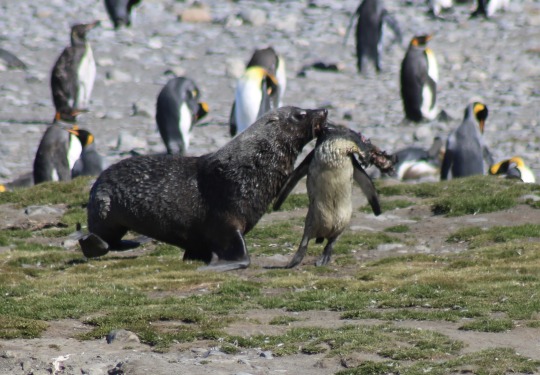
Here a young fur seal has killed a King Penguin and ran down the beach 50 yards. He would drop the penguin, then chase any other fur seal in his path. Retuning to grab the dead penguin and run some more. Although fur seals will eat a penguin. It is usually done as a last resort. In this case it was explained that more than likely, it was a young male which was having raging hormones and acting out.
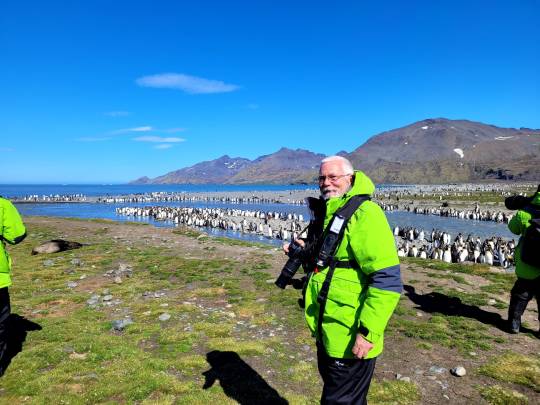
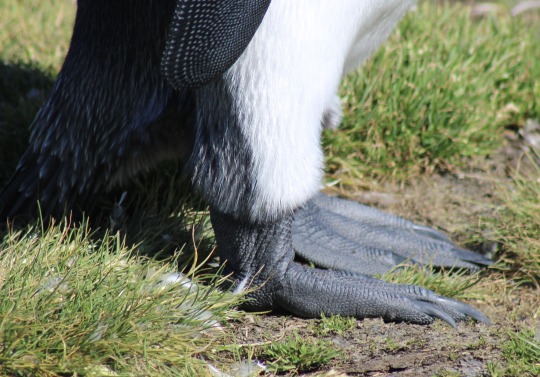
Try walking a mile uphill with these short legs.
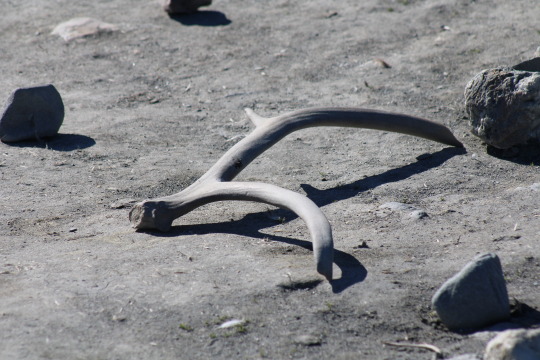
The Norwegian whalers introduced Reindeer to the island in the early 1900’s. There is an eradication program in effect. It is thought that all Reindeer have been exterminated. Is this antler a historical artifact or recently dropped?
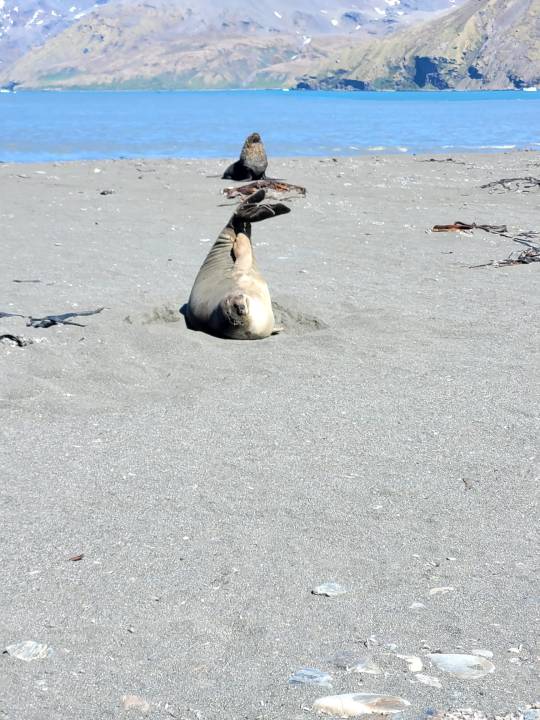
Elephant seal yoga!

King Penguins are beautiful.
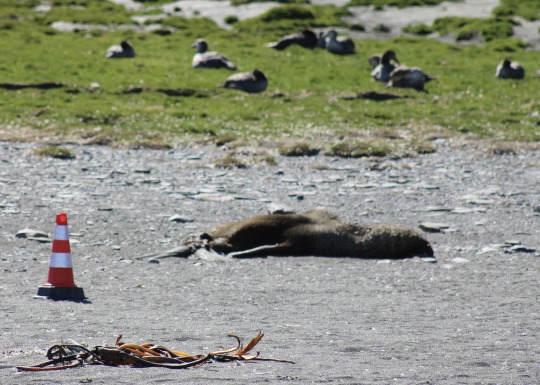
Here the orange cone denotes a dead seal. The skua birds will pick the bones clean.
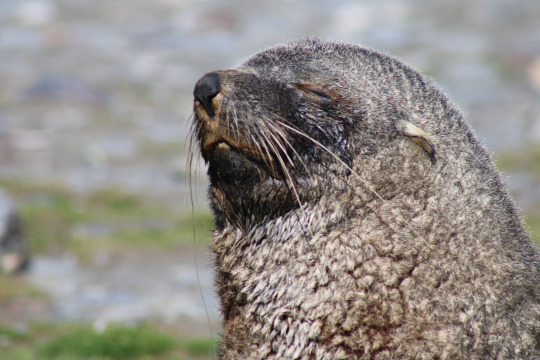
Here is a fur seal up close, they are easily recognizable by their ears.
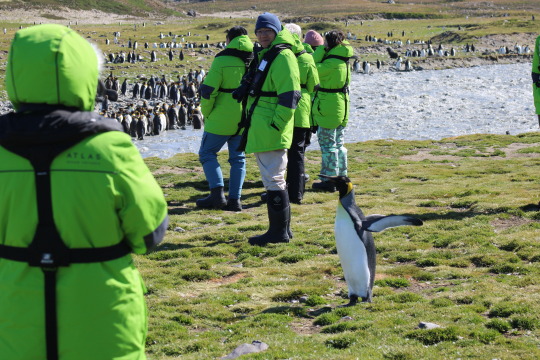
Out of the way! Penguin coming through!
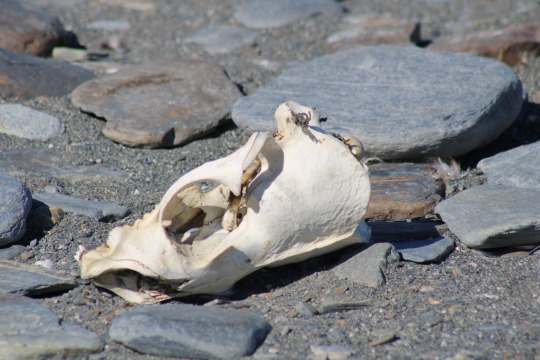
Seal skull.
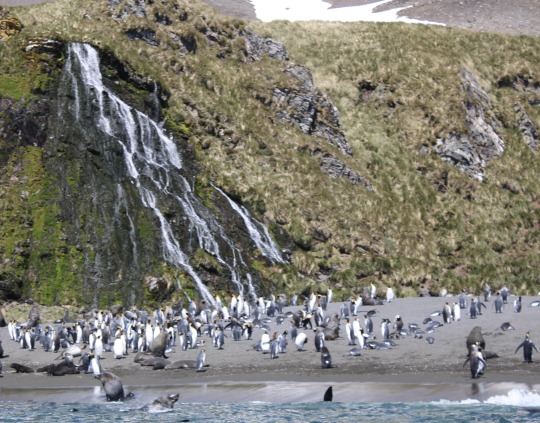
Due to the massive amount of penguins, we could only walk a quarter mile. So we returned to the zodiacs for a “zodiac cruise” down the coast.
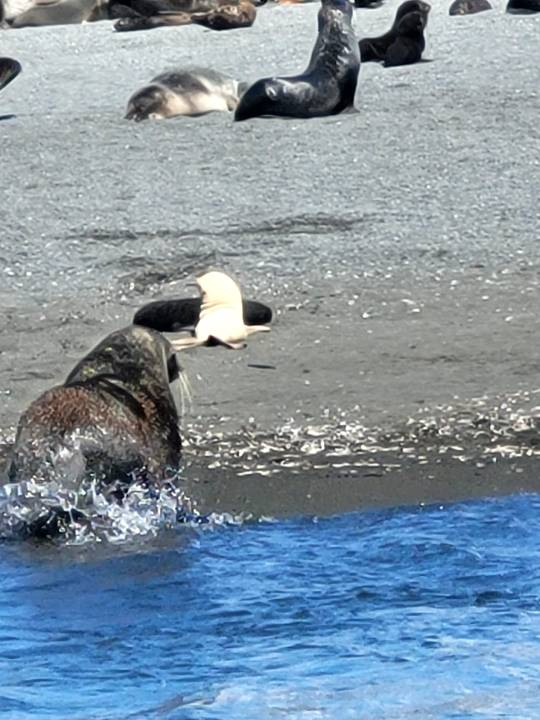
On the left side of the photo is a “blond” Fur seal pup. These are not albinos, just a totally blond fur. This happens in about 1 out of 800 births.
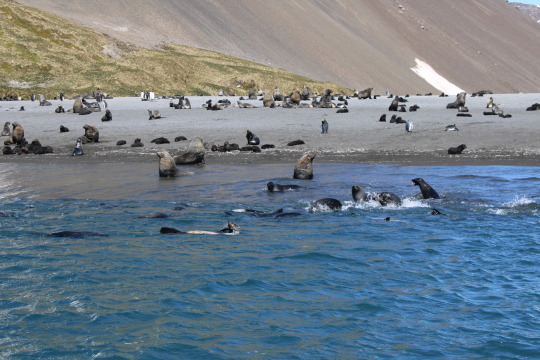
The water is alive with penguins and seals frolicking.
This is one of our top two sites we visited, due to the amount of wildlife that we could get close to. You could spend a day here watching this. It was like a constant 3 ring circus, times ten. Everywhere you looked something was going on. Penguins were walking right by us. Juveniles posing in their hilarious molting stages.
0 notes
Text
Grytviken, South Georgia Island. Dec. 24-26, 2024. Part 4.

Anytime we were within sight of land. Penguins and fur seals frolicked around the ship. Here is an action shot of a penguin shooting out of the water and about to reenter.

After leaving Port Stanley, we spend two days at sea traveling to South Georgia Island. The Captain opened up the bridge for guests to see. We attend multiple lectures each day to kill the time.

We do another bio-security check of our outer clothes during sea days. Here Expedition guide Giuliano, from Peru, double checks our gear. We will have a make or break inspection by the South Georgia Official when we get to Grytviken. If they find a few to many deviations we will not be allowed to land. The future of this ship coming back this season is also in jeopardy. While we are responsible for our clothes, the expedition guides are deep cleaning all 150 pairs of our boots in the mud room.

Nancy enjoying the hot tub after her sauna.

One afternoon there was a special on the aft deck of hot Asian soup. The poor server has to wear a Antarctic jacket to stay warm out here.

If you spend enough time on deck you will see Humpback whales exhaling steam (see center of photo). We could see up to 4 whales at a time a half mile away.

More hors d’oeuvres just to help get us to dinner. These are quickly followed by champagne.

Christmas eve at sea.

Fur seal welcoming us to the old Norwegian whaling station Grytviken.

As we pull in to Grytviken the Albatross Expedition ship pulls out. These ships are tightly controlled on when and where they can bring passengers.

This is Grytviken. 1.6 million whales were killed in the Southern Ocean between 1904 and 1986, this being one of the primary whaling stations. Over 100,000 Humpbacks were killed. The Humpback whale population just about collapsed in 1960’s. The population was down to 5,000 when whaling stopped. Now it is back to 135,000.

Our landing site will be to the right of the derelict ships between the blue barrels. There are three large fur seals at the site. The expedition guides had to keep them at bay. We are not allowed to get within 15 feet of the animals if possible. Sometimes they walk up to and between us. If they charge you, you throw up your arms or clap. They usually stop, then slowly back down….usually!

Here are two of the derelict whaling vessels. These carried huge harpoon cannons on the bow. They would tie up to 8 whales to the sides and tow them back for processing.

This is the museum with whale bones, harpoon guns and anchors on display in the front yard. Laying among the displays are fur seals.

Here is a large fur seal scratching an itch.

Two pups and an adult fur seal hanging out. The babies are usually crying out to be heard by their mom. It is very noisy where fur seals congregate.

Nancy walking to the Norwegian Church built in 1913. It had been prebuilt in Norway. Disassembled, then transported to Grytviken in pieces. Originally known as “The Whalers Church.” It was a Norwegian Lutheran Church.

The inside was decorated for Christmas. The front door was propped open with a heavy harpoon head.

In the back left was a library complete with book check out cards. Would love to see what the actual books were. I assume many are Ships logs.

A private sailboat was tied up to the dock. A lone German sailor onboard, preparing to sail to South Africa. Temperature today is a high of 40 F, so the parkas are needed.

Juvenile King penguins still molting their feathers. They can not go swimming until all the feathers are dropped. There is a lot of squawking going on here. The white things on the ground are their feathers.

Nancy in the Grytviken cemetery. Even though there is a fence around it, the baby fur seals get under the fence and hang out. As with most early Christen cemeteries, the graves face easterly to receive the second coming of Christ. There is one grave in the back with a large headstone and it faces 90 degrees to all the others. That is the final resting place of Sir Earnest Shackleton, of Antarctic expedition fame.
There are 64 graves, mostly whalers. The earliest graves are from the sealers in the very late 1890’s. In 1982 a POW Argentine submariner, Felix Artuso, was buried here. He was shot during the Falkland invasion on a submarine in the harbor. Basically due to language differences.

Sir Earnest Shackleton’s grave. He died in South Georgia on his third expedition to the Antarctic in January, 1922. His head is towards the South Pole where his heart lies.
Nov. 2011 the ashes of Commander Frank Wild were buried to the right of Shackleton’s grave. The inscription is, “Frank Wild 1873-1939, Shackleton’s right hand man.” Wild died two weeks before WW2 broke out. His ashes were lost until recovered in a crypt in Johannesburg, by an author writing a book about him.
Talking to some of our ship’s officers they talk about visiting these two graves as often as they can, to pay their respects to such legendary seafarers.

Fur Seal pups are everywhere.

As are King Penguin juveniles. You can see the white feathers on the grass where they have molted.


These are the tips of the Harpoons. The modern Harpoon gun was invented in 1864 by the Norwegian Svend Foyn. These tips would have a grenade between it and the shaft. On impact a glass vile of sulfuric acid would shatter and set off the grenade.

This is where the blubber would be boiled down. The whalers could completely carve up a 40 foot whale on the slipway in 20 minutes.

We wade in the water to loosen any bio matter from our boots. Then the Expedition guides scrub the bottom of our boots before we board the zodiac. Unfortunately we did observe several dead elephant and fur seals. Which emphasizes the importance of the bio security measures.

Back to the ship. This was one of the top two places we stepped ashore. Mostly because of the associated history. It was also our first time walking around the penguins and seals.
0 notes
Text
Port Stanley, East Falkland Islands. Dec. 23, 2024. Part 3.
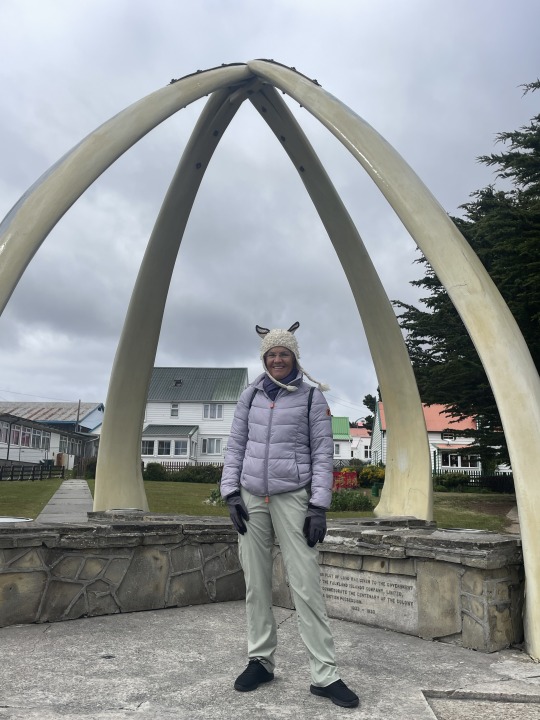
We disembarked at the Government dock outside of Port Stanley. Temperature was around 50F. No need for our heavy coats or boots. Above Nancy is standing under 4 whale bones made into an arch. These are jaw bones from Blue Whales. The 21 foot arch was built in 1933. Realize that another 3 feet of the bones are buried in the ground.
We have several friends who have been here. Never thought we would. So cool to see this British outpost in person.
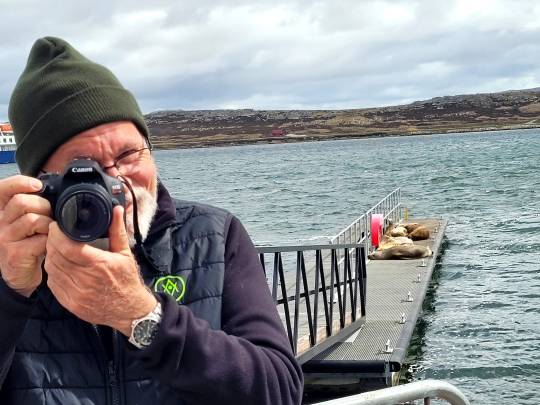
We get dropped off at the community dock by the bus. The seals on the dock are the first seals we have seen.
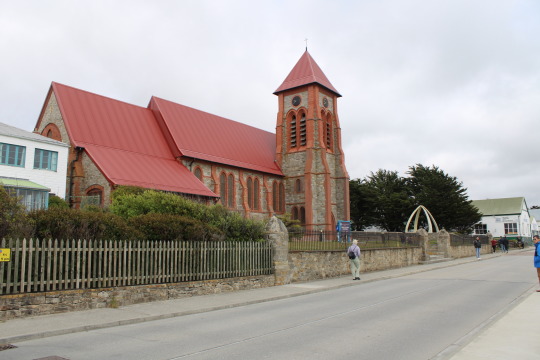
The Christ Church Cathedral is the largest church in town built in 1892. It is the world’s most southerly Angelican church. With the whale bone arch to the right.
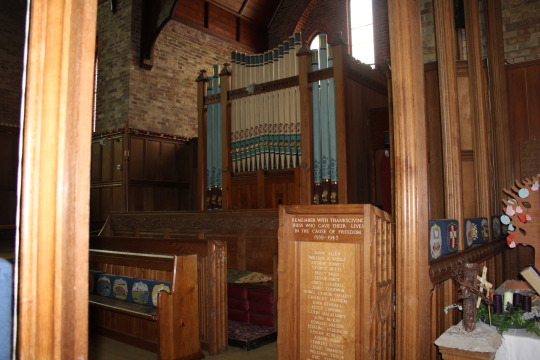
It was simple but beautiful church inside complete with two organs built in Ireland.
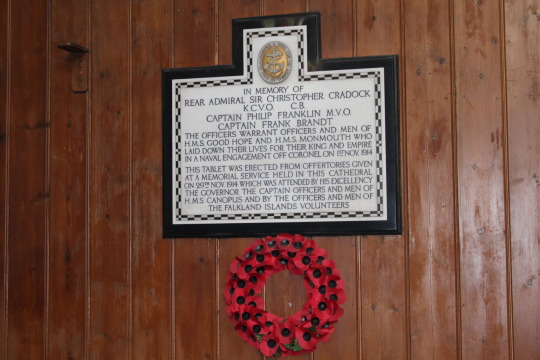
The walls were covered with memorials to Falkland Islanders lost in wars or at sea.
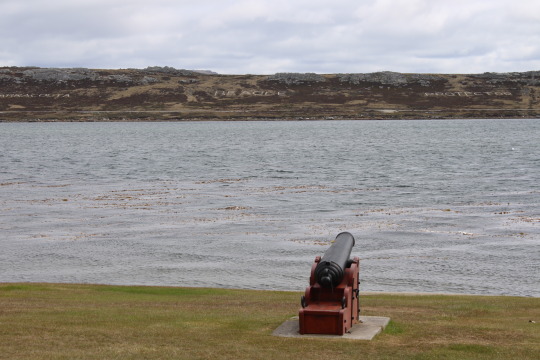
Across the harbor are the names of British Warships that spent time in the harbor. The list includes: Beagle, Endurance, Protector, Barracouta and Dumbarton Castle. I must say this is probably the most pro-British colony in the world. Most establishments and several homes would have a small British flag in the window, or a full size flag flying in the yard. One house high on the hill had an entire flag painted on the roof. No other British colony has been invaded in recent memory, then saved by the motherland.
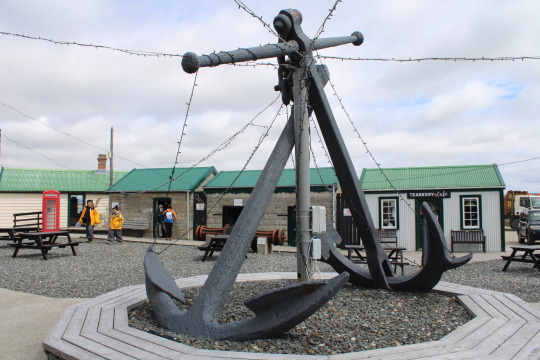
This is in the square in front of the Falkland Islands Museum and National trust. We had a nice chat with a gentleman who elected to stay during the Argentine Invasion. He was a math teacher and wanted to experience history in the making.
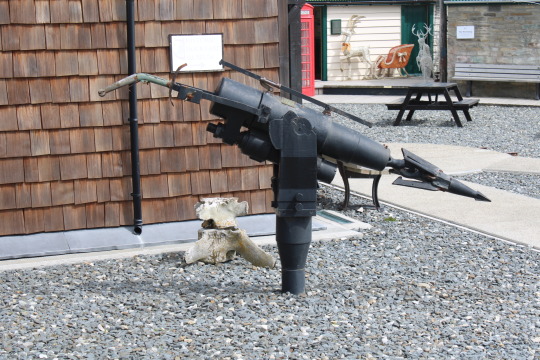
This is a beast of a Harpoon gun at the museum.

Nancy in one of the museum sheds. The large shovel is a “peat shovel.” Port Stanley has had two peat avalanches in the past. One avalanche killed two people and cut the city in half. They had to use boats to get from one part of the city to the other.

This is a skull from a Leopard Seal.

I found the side molars very interesting. They remind me more of sharks teeth. The Leopard seals do eat krill and can filter the water out of their mouth through the teeth and keep the krill in.
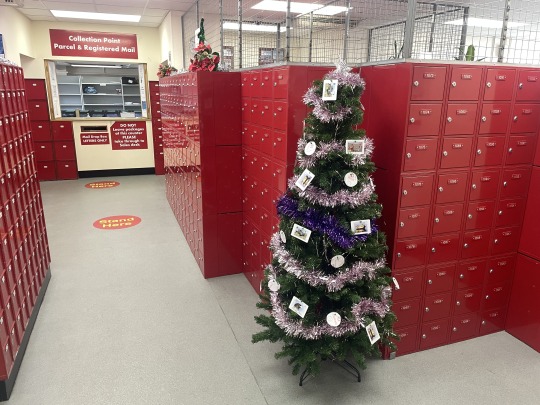
This is inside the Post Office. Mail is not delivered to houses, everyone has a PO Box.

Cute town.


The local newspaper, Penguin News, is published weekly.
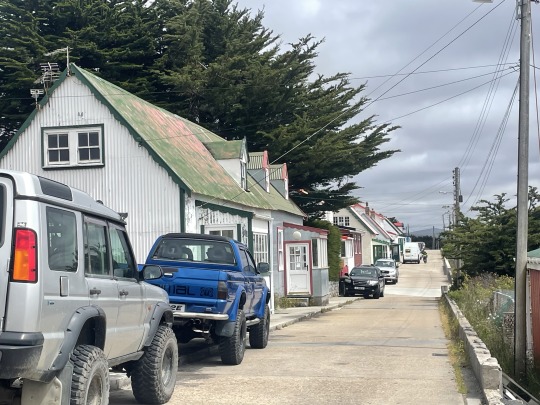
We enjoyed strolling up and down the few streets in town. About 3,600 people live in the Falklands. The majority in Port Stanley. Range Rovers are the most common vehicles. Not wearing the obvious Cruise coats, the locals all waved to us when they drove by. I do believe it is a love/hate relationship when the cruise ships are in town and people are gawking.
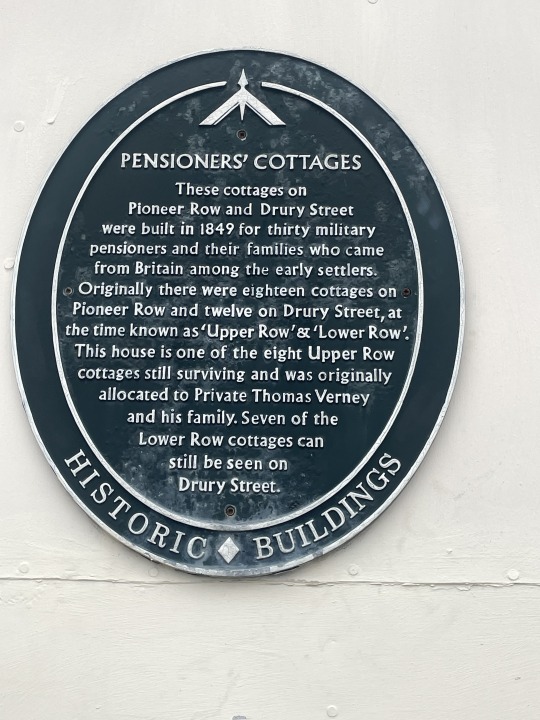

Pensioners house.
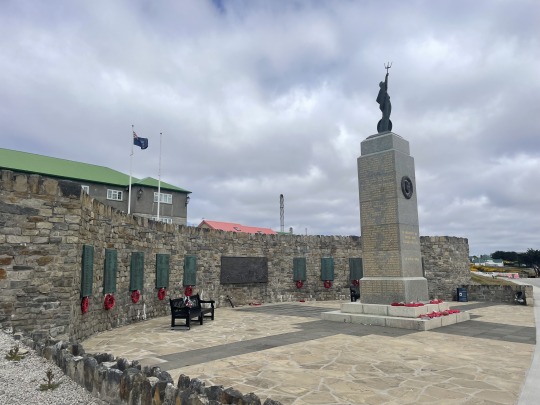
One of several war memorials in town. The war in 1982 lasted 10 weeks. There are still mines on the island. 255 British servicemen were killed and 3 Falklanders.


Before leaving town we had “Fish and Chips” in the Victory Bar, paying with British pounds left over from Wales. Receiving Falkland pounds in return, which we donated to the Falklands Veterans fund.
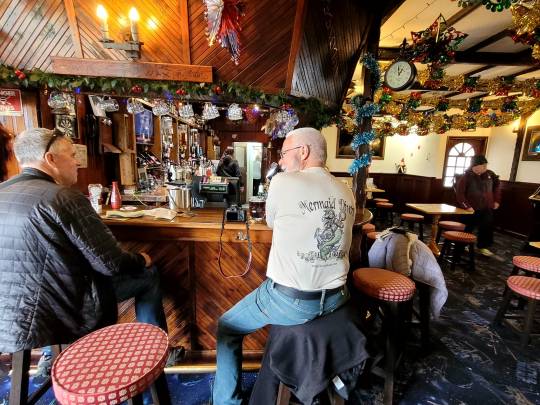
Fish and Chips in the Victory bar.

Then it was back to the bus for the two mile ride to the ship. Here is Wei “David” Chen and Nancy in front of the national flag of the Falklands. David was the social butterfly of the cruise.

Before coming to shore and again leaving, we walked through a spongy mat full of an anti-viral solution. This is part of the bio-security process. Next stop South Georgia Island.
0 notes
Text
Carcass Island, West Falkland Islands. Dec. 20, 2024; Part 2.
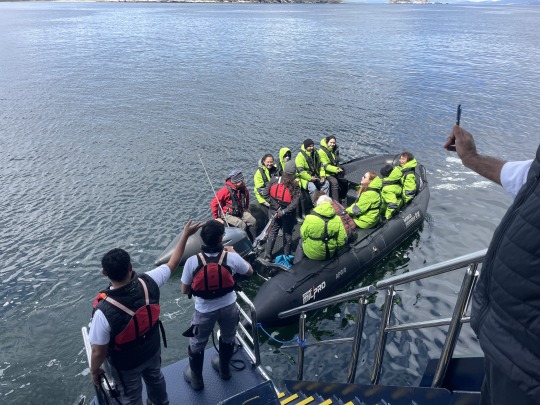
Nancy gets the last seat in the zodiac and leaves me on the ship.
The island was named after the British ship, HMS Carcass, that did the first survey here in 1766. The island has been owned by R.P. Magill for over a century. Three historic building are still on site. No rats or cats on the island allow many species of birds a great place to nest.
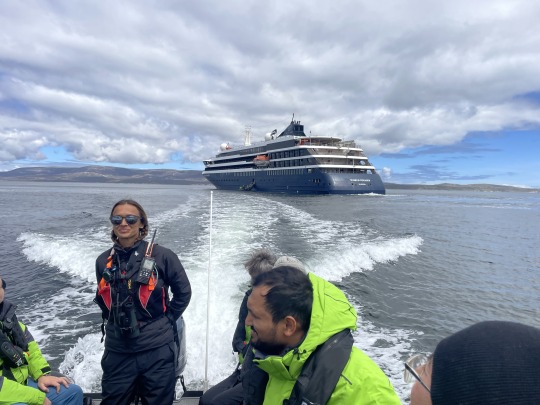
I catch the next zodiac, driven by guide Florincia “Flor” from Buenos Aires. This will be our first “wet landing.” There is no dock or pier to get on. So we scoot to the front of the zodiac after the driver noses it on the rock pebble beach. Swing your legs over the side and step in the water. Luckily it was never deeper than our shin high boots.
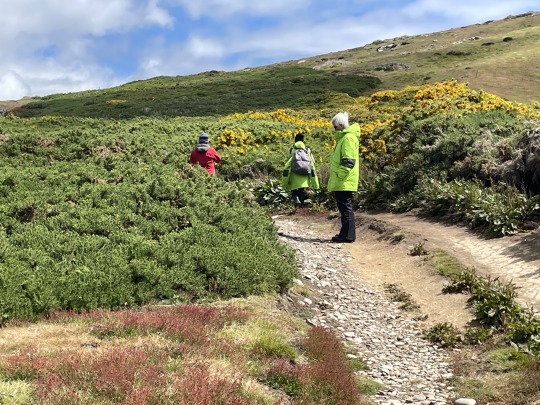
Short walk along the shore. Several penguins have hollows in the peat they duck into.
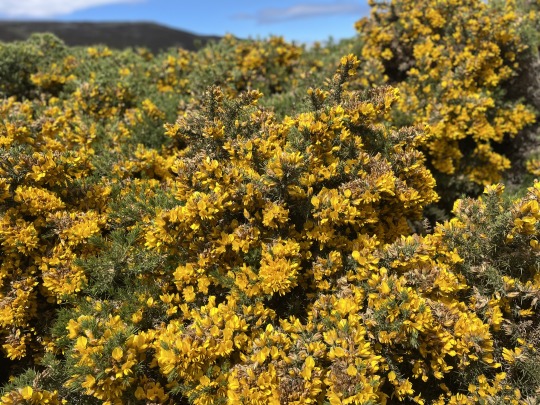
Thick brambles.
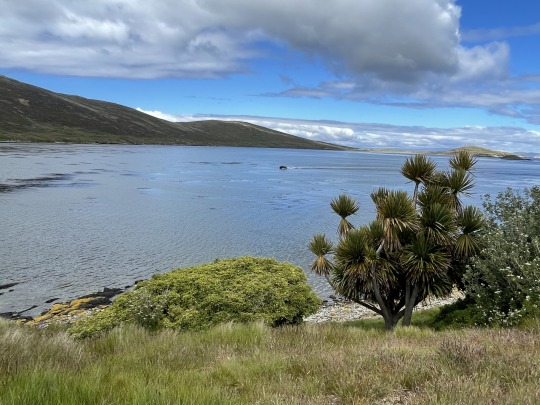
Several species of plants came from New Zealand. The Night Herons love them for nest.
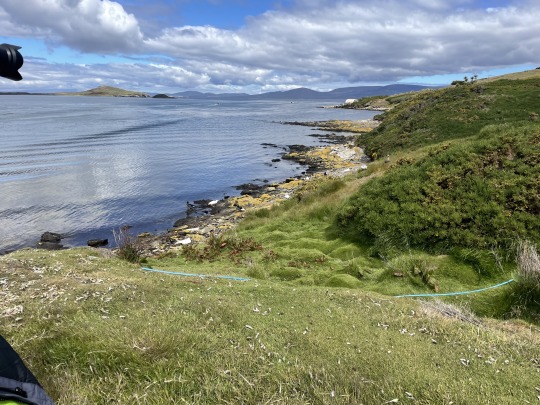
We did see our first seal off in the distance along the shore.
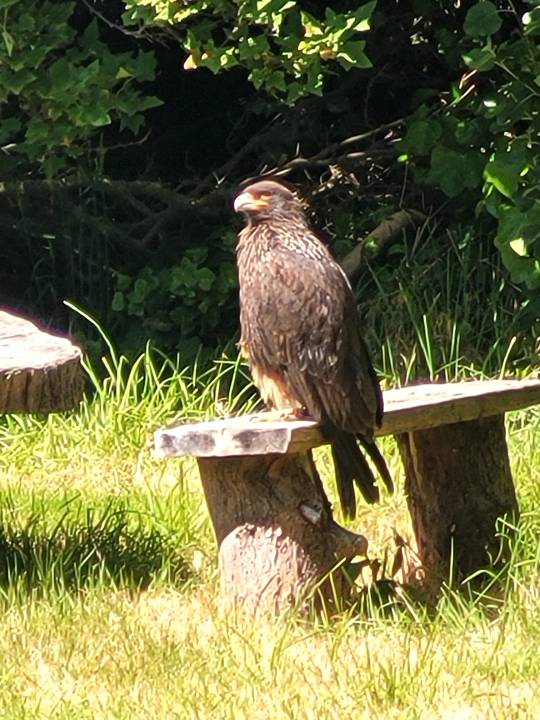
Some sort of hawk.
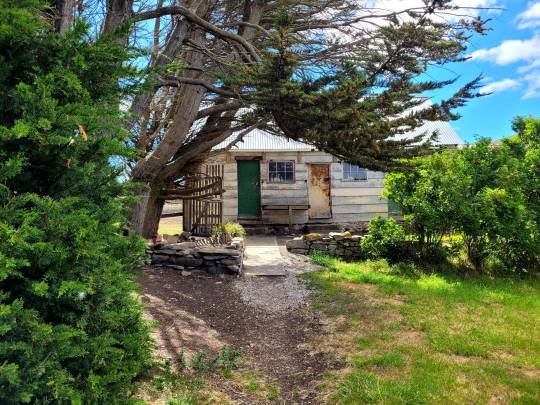
The family of care takers make pastries and tea for the passengers. They had one school age boy on the island for the Holidays. Nancy could not get much information out of him considering school and travel.
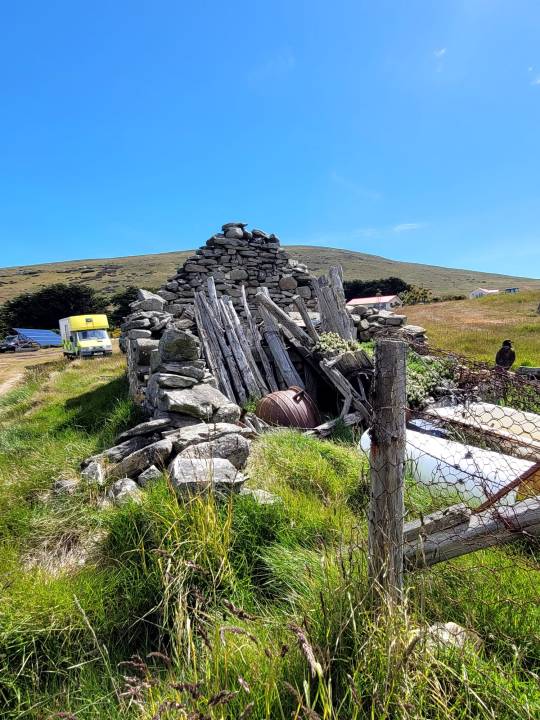
This is an old building that has collapsed. Might have been a house or a barn. Note the cast steel “Try pot” used for boiling down seal blubber. Sealers were working in the Falklands well before the whalers. I assume the islanders boiled their clothes in this in later years.
This was about the least interesting shore excursion we did.
1 note
·
View note
Text
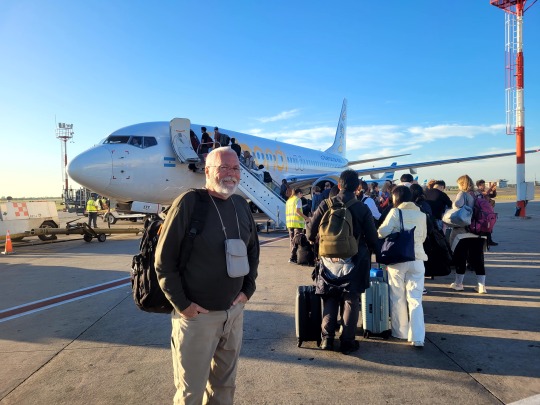
It’s official, Dec. 19, 2024 we are off to the Antarctic for a once in a lifetime adventure. This is a 16 day trip on an “expedition style” cruise. Wise people book these a year in advance. We booked it 10 days out. We did buy a book on “What to expect on an Expedition Cruise.” Looked like we would be in the heart of baby penguin season. Not bad timing for last minute, eh!
Three ways to visit Antarctica. Either fly directly to the continent and stay in some yurts or something. Very expensive and little to no wildlife. Or take a ship. Two types of ships travel there. Large cruise ships with 200-500 people, which are not allowed to land any passengers anywhere. They just keep cruising by land and icebergs. The third way to see Antarctica is “Expedition style.”
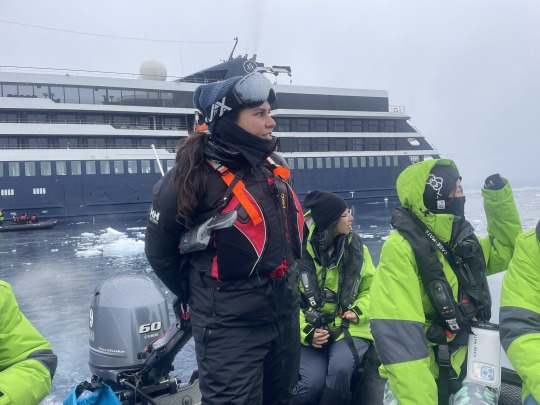
Tourism is highly regulated here. No more than 100 people at a time are allowed at any site. We are ferried by large zodiacs to shore or sometimes only a zodiac cruise if a landing is too risky. In the background is our ship the Atlas World Voyager. It can hold 200 passengers with a working crew of 133.
On this trip, there were only 150 passengers. Around 60% were Chinese. Many of them ex-pats living in Canada. The majority of passengers spoke multiple languages and had at least one PHD, if not two. This sub-set of travelers have been to every corner of the world. At least three had been on Gorilla trips. Many had one or more safari trips. Several had been to the Arctic circle or photographed polar bears. The average age was much less than you would assume, maybe 45-55. I was slewing the Bell curve at 68.
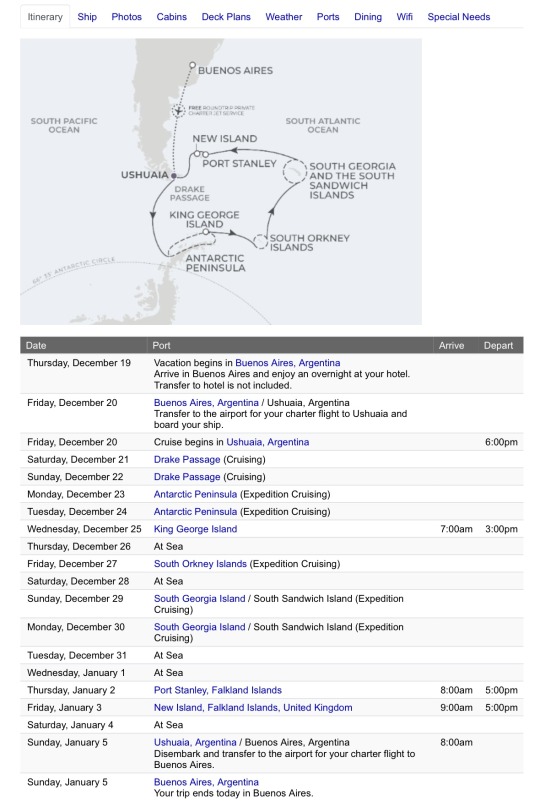
This was the supposed itinerary. We actually did it in reverse order which damn near caused a passenger mutiny when they did not place a foot on their 7th continent. Many passengers prioritized the bragging rights of stepping foot on Antarctica, over seeing all the wildlife we saw.
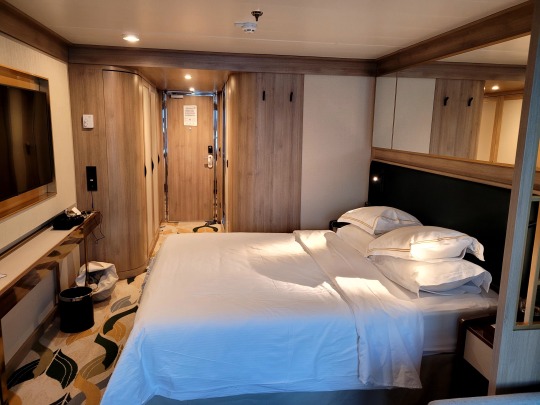
The charter flight to Ushuaia, Argentina was around 3 hours. We were bused to a cafe in the National Park for lunch. The World Voyager had just off loaded the previous passengers and were busy reloading supplies and cleaning rooms. They have this down to an art. We were then driven to the ship, and given ID cards. The friendly staff then escorted us to our rooms where are luggage was waiting for us. As the young man we were following, started up the stairs from the fourth deck meeting area. We told him our rooms were on deck 3 below us. After a quick check he said that we had been upgraded to deck 6. What a surprise! We expected a 2’ x 3’ portal eye level with the whales and seals.

Instead we had a private balcony with a huge sliding door. The whole deck 3 was empty, we would have been the only passengers down there. Livin’ right!
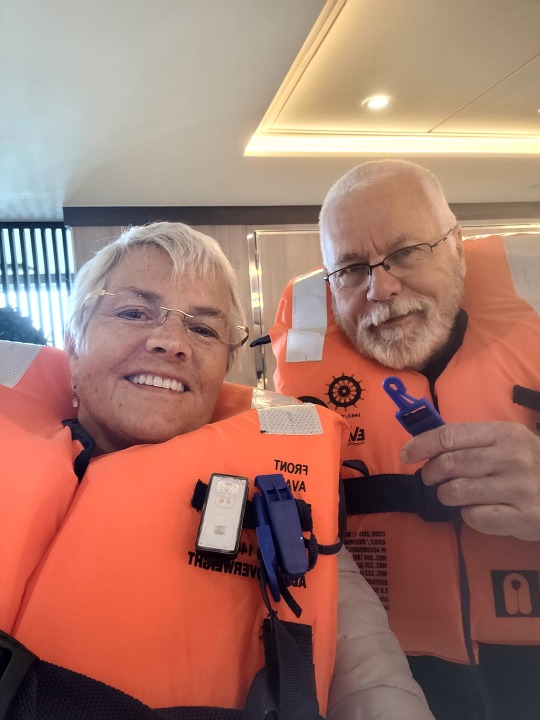
After watching the Safety video in our room. We were required to bring our life jackets, that stay in the closet, to deck 4 Muster Station 1. Hoping they stay in the closet the rest of the trip. Water here is a bit chilly.

We attend the meet and greet with the ships officers and other guest. Here Nancy is talking to Capt. Terje Ulset, a Norwegian. Ships officers are mostly Portuguese. The Doctor is Romanian as is the staff nurse.

For the next 14 days it was non stop eating great food and drinking fine wines. Sometimes we endured 2 hours without some kind of a meal, snack or high tea. Seating was casual. You could eat breakfast and lunch buffets any time during a 2 hour window. But dinner was staggered 30 minutes between deck 6 passengers sitting down at 1900. Then deck 5 passengers sitting down 1930. Dinner was always a 3-5 course dinner from the changing 5 star menu.
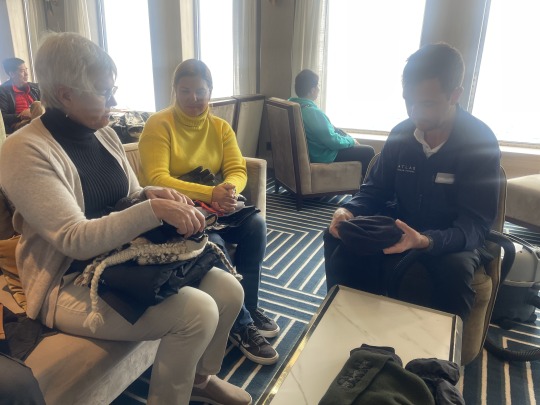
After exiting the famous Beagle Channel we steamed two days to the Falkland Islands. During the first day we sat through a Bio Security Check. Every piece of outer clothing we might wear on any island is checked for the smallest seed. This is taken very seriously. Besides bringing in an invasive species that could destroy the environment we need to be concerned about moving any disease from one penguin colony to another. Above one of the Expedition guides John does our Bio Security check. In October of 2023 the Avian Bird flu, Highly Pathogenic Avian Influenza (HPAI), was detected on South Georgia island. This has the ability to kill 95% of all the birds and seals in a colony. It probably arrived by migrating birds and not humans. Penguin colonies can be 100,000 birds with hundreds of seals mixed in. We spotted dead seals at every landing ashore. Luckily not a high percentage but still concerning.
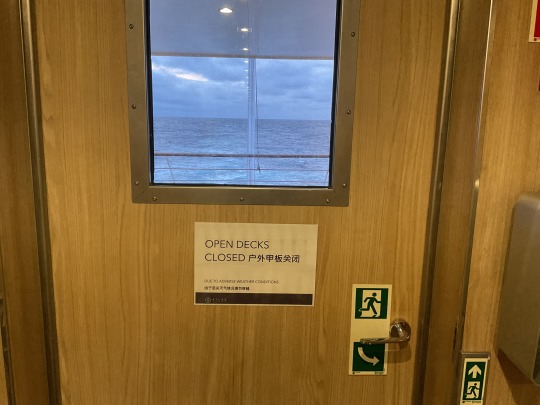
During the open sea crossings the decks were off limits.
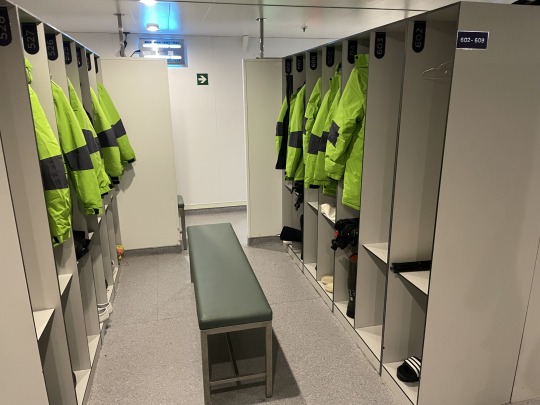
Deck 3, Mud Room. We each had Green Atlas Jackets, Inflatable Life Jackets and heavy boots in these receptacles. We get to keep the heavy jackets. The passengers are divided up into 25 person groups. Nancy and I are in the “Icebergs.” Each group meets on deck 4 and then brought down to the mud room in intervals.

Here we are about to board the zodiac for the first time. Our ID’s have been scanned. When we come back aboard we will step through the boot wash machine on the right. It scrubs and sprays our boots with disinfectant.

About to make our first landing at West Point Island, West Falkland Islands. This will be a “dry landing” coming along side a small pier.
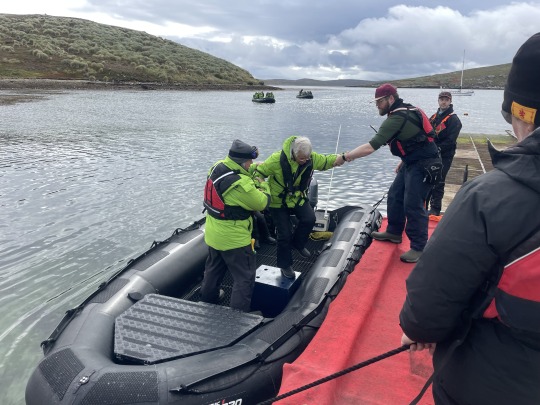
Everything is done by the book. Here the head of the Expedition Team, Aaron takes Nancy’s arm in the “Sailor’s grip” to help her to shore. Aaron always meets each zodiac when they come ashore giving directions, cautions and time to return.

Above is the route we hike from the farmers residence on the east to the penguin colony on the west. Temperature is around 45 F. We end up getting very sweaty in these heavy coats. Only later do we learn there are shoulder straps on the inside of the jacket. You peal off the jacket and then it hangs off your back like a back pack. Wish we knew that earlier.
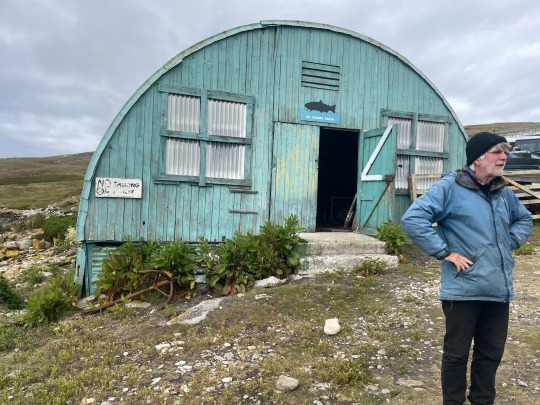
This is the German ranch manager. He lives on a sailboat in the harbor. He gets to Port Stanley once a year. Food and supplies are delivered once a month. They ranch sheep here.
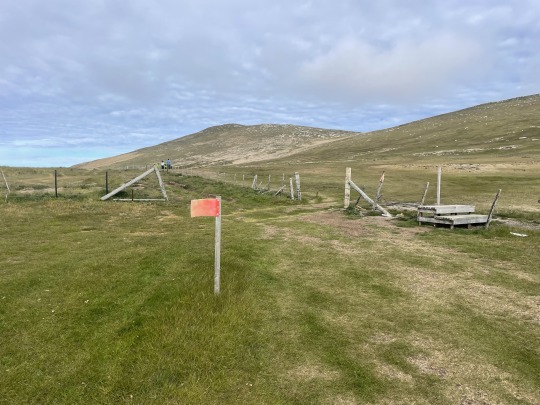
We follow red flags for the trail. These are permanent, later trips temporary red flags are placed for us to wind in and out of the animals.

The Expedition guide Ana, directs Nancy to step into the disinfectant before walking down to the Albatross and Rock Hopper nesting site.

We are in over our heads in centuries old tussocks. Theis area is deep peat from the grass.
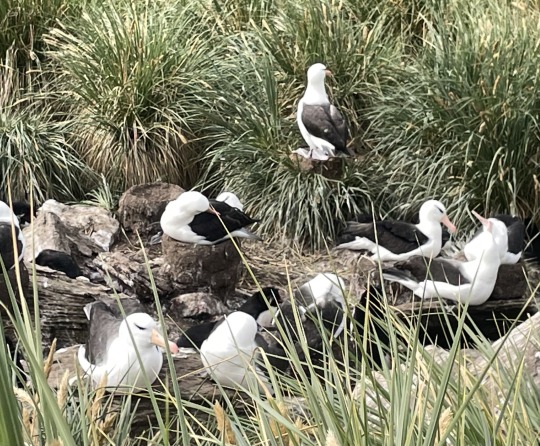
We get within a few feet of nesting Albatrosses. Several birds are constantly flying just over our heads. Interspersed between the Albatrosses sitting on foot high peat nest, are Rock Hopper Penguins with their new borns.
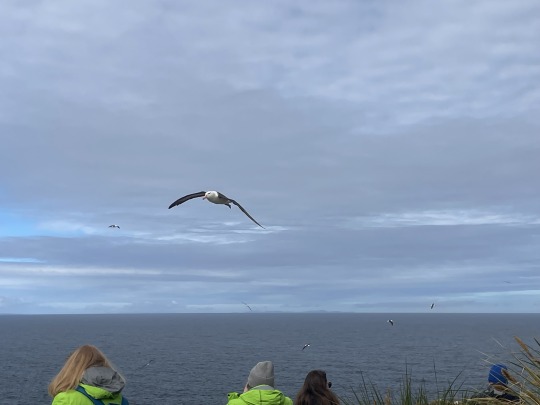
Albatross buzzing by.
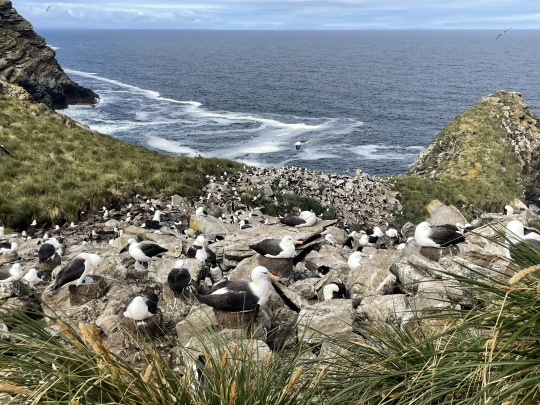
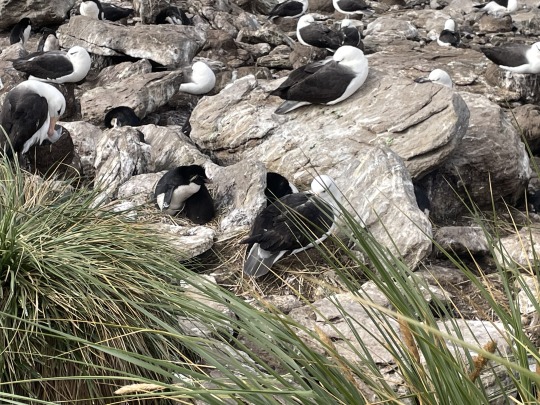

Baby albatross being groomed by parent. Note the peat nest they make.

Rock hopper penguin with its chick dead center.

More Rock Hopper penguins.
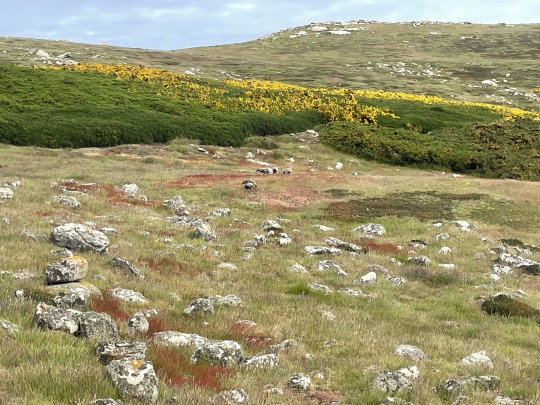
Rolling tundra like hills. Several geese in the far side of the photo.
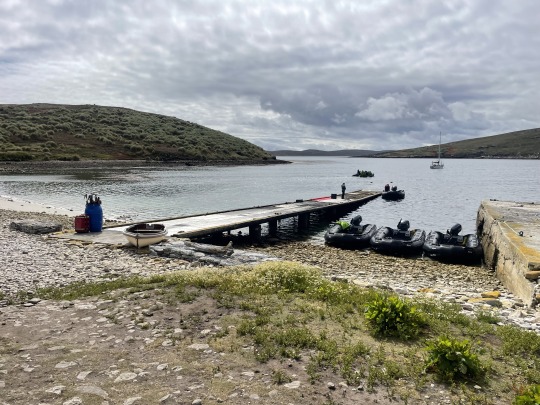
Back to the jetty for our ride back to the ship. We usually get to spend about 2 hours ashore. Til the next group gets their turn. We did not see any dead animals on this excursion.
Once aboard we will go through the boot scrubbing machine then have our ID’s scanned before leaving our gear in the mud room.

We will be welcomed back aboard with hot towels, warm drinks and rocking music. Anyone want a shot of Bailey’s? Nancy and Albi hamming it up with her Llama hat.
Once everyone is onboard the ship will move a few miles to our next shore excursion during our lunch break.
2 notes
·
View notes
Text
Buenos Aires, Argentina. Dec. 17-19, 2024
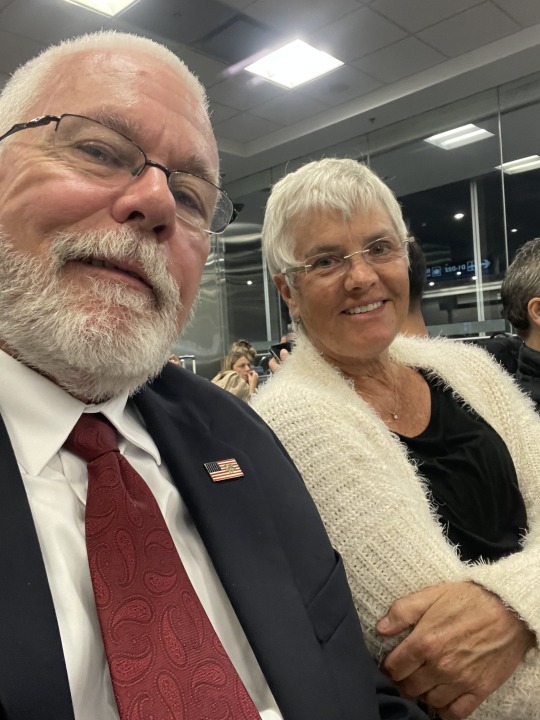
Nancy and I flew to Buenos Aires (BA) Argentina a few days before our Antarctic Expedition. We flew on the red eye from Miami direct. Nancy made reservations at a great hotel, Claridge Hotel (circa 1946), walking distance to the historic downtown. After checking in early we roamed the streets getting a lay of the land. The next two days we did a walking tour of the city.
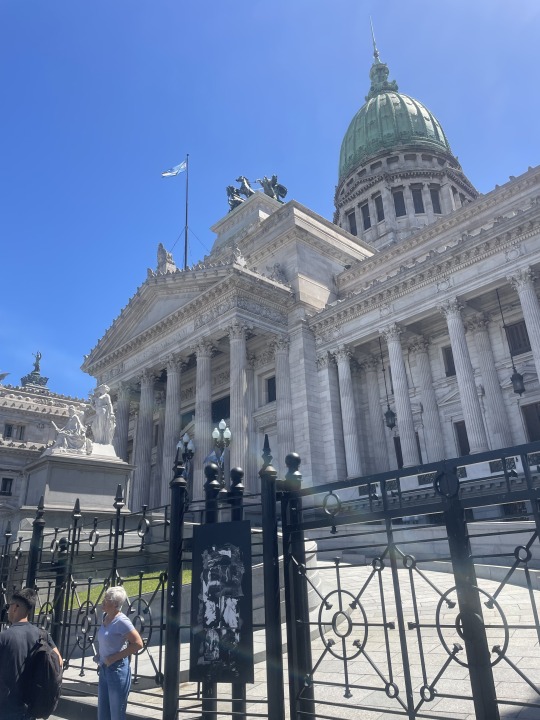
We met our first guide at the Congress Building. So many countries, Argentina included, had adopted the US style of two houses of Congress.
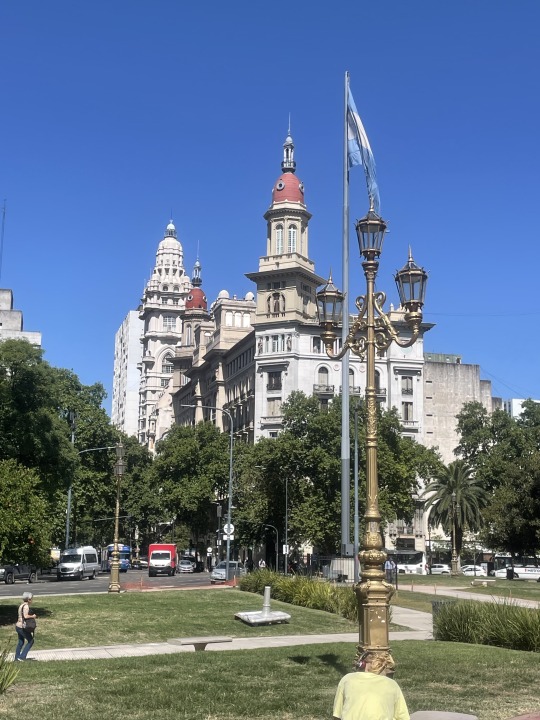
The city is full of beautiful architecture dating back to its hay day of great economic wealth. The emigrants wanted to show how well they had succeeded, and mimicked the best that Europe had done.
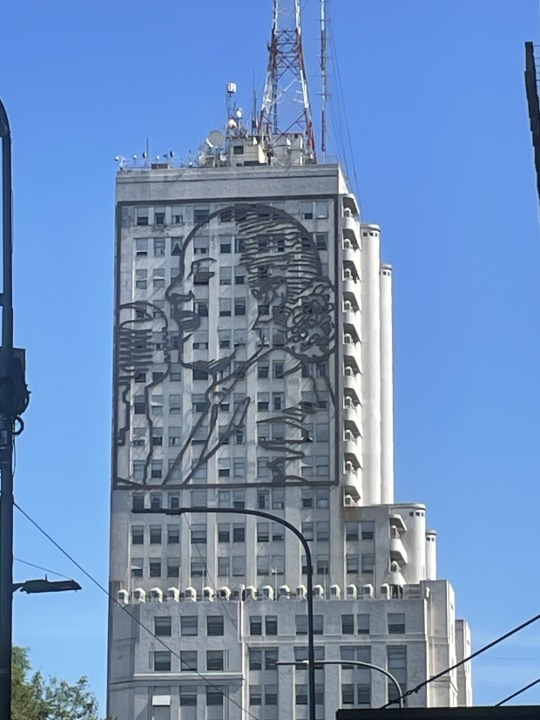
This is a homage to the famous Evita Paron. Here she is talking into a microphone and not about to eat a hamburger. She was the first lady of Argentina from 1946 to 1952. People loved her. But either loved or hated her husband.
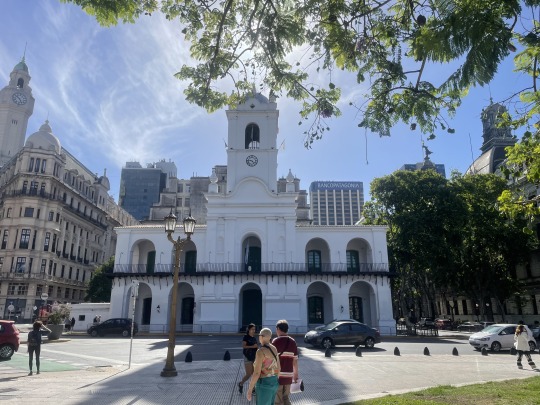
BA city planners leveled entire blocks to produce large Boulevards through town. It makes a beautiful city today but certainly impacted many people when they did. The building above is where the original colonial group met to declare Argentina county. It too was partially torn down to make way for the center boulevard. Originally it had 11 arches.
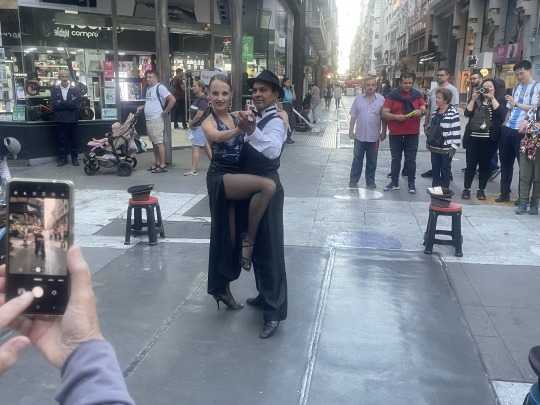
Argentina is famous for its dance, “The Tango.” We came across these two professional dancers working the street for tips. There are several dinner shows available at night.
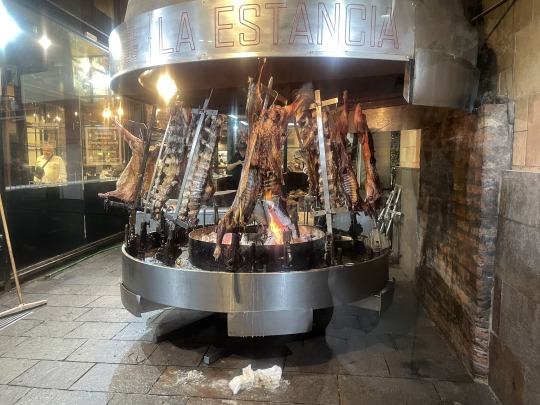
Argentina is also famous for its great meat. We ate at this restaurant where they put hot coals in a pot and bring it to your table with a variety of meats and sausages still cooking on it. Some call this meal “Death by meat.” We were stuffed and yearning anything green afterwards.
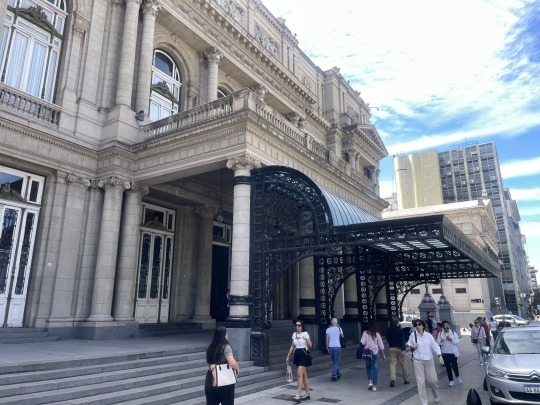
Day two, we met our second guide at the Opera building and did a long walk to the cemetery. Beautiful day not a cloud in the sky. These guides are very knowledgeable and passionate about their country. And also honest about petty crime and runaway inflation.
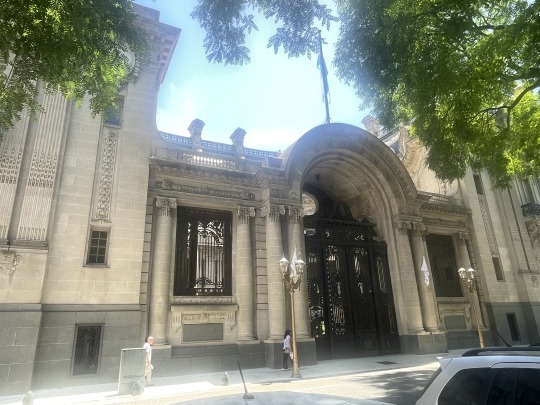
We passed huge mansions showing off the wealth and egos of their prior owners. There was a lot of showing off in the day.
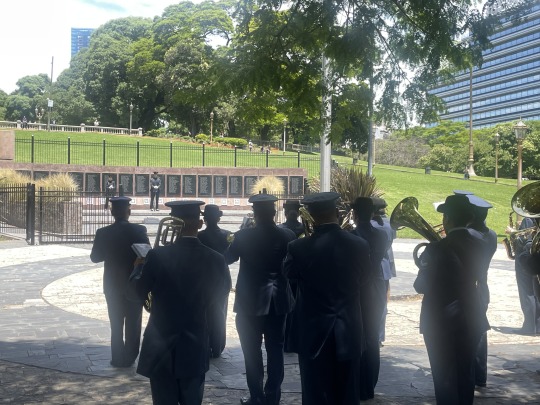
This was the Argentina Navy Band playing at a memorial to service members killed in the 1982 invasion of the Falkland Islands. 649 Argentines lost their lives, compared to 255 British servicemen. Argentina still claims the Isla Malvinas as theirs. Argentina and Chile do not like each other either.
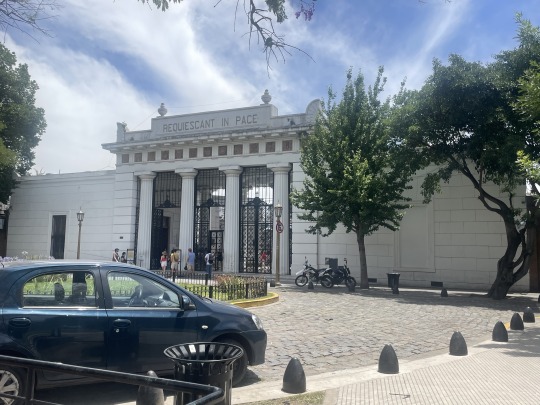
Our tour ended at the gate to the cemetery. We took a break for lunch then joined our second tour for the day.
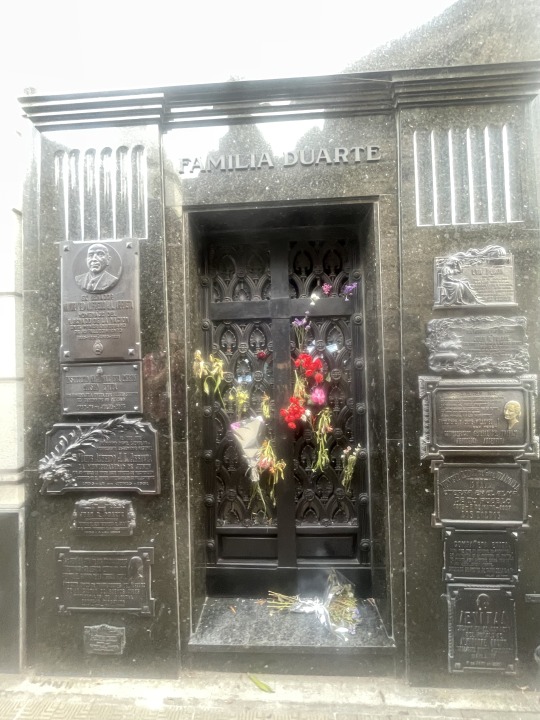
At the end of a great 2 hour tour of the cemetery we saw the famous grave of Evita. For a really bizarre story, look up the travels of Evita Peron after her death.

This chart shows the inflation in Argentina over the last year. In April it was at an all time high of 289%. Basically knock three zeros off of the peso cost of an item to convert to US dollars. A 3,000 peso empanada cost $3 US. It goes up daily so you only cash US dollars that you need for the day. It takes a fist full of pesos to buy anything. Money changers are every 100 feet on certain roads, singing out their trade.
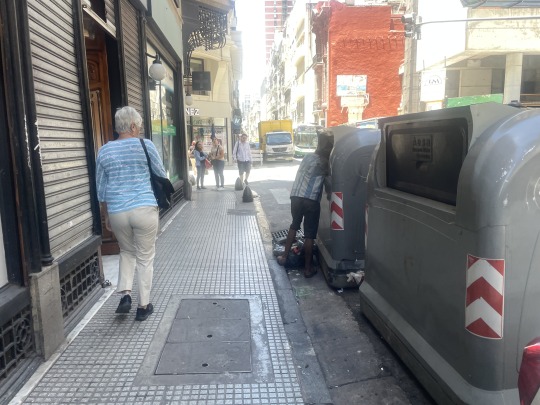
Life is tough here now. The guides had said petty crime is up, people are rummaging through garbage cans. Which we witnessed multiple times.
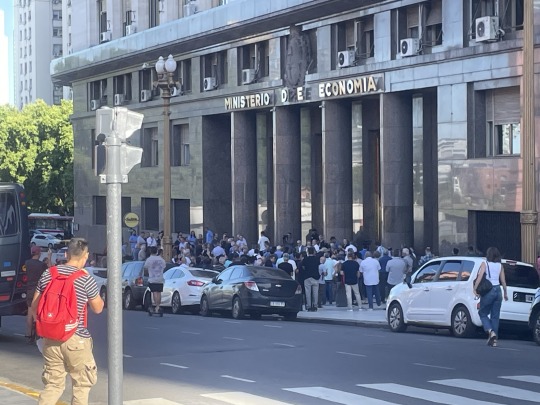
Protest happen daily in the Capital city of Argentina. They are well established, news media, paddy wagons (buses) and ambulances are standing by. Police have some heavy duty crowd control vehicles right around the corner if things turn ugly. All monuments and statues have large unsightly fences around them. This demonstration is about inflation and economics.
We saw several graffiti symbols of old protest concerning the “Mothers of Plaza de Mayo.” Protesting the disappearance of 30,000 children during the Dirty War of 1976-1983. They no longer hold their weekly protest, but the white scarf symbols are still seen around the Capital.
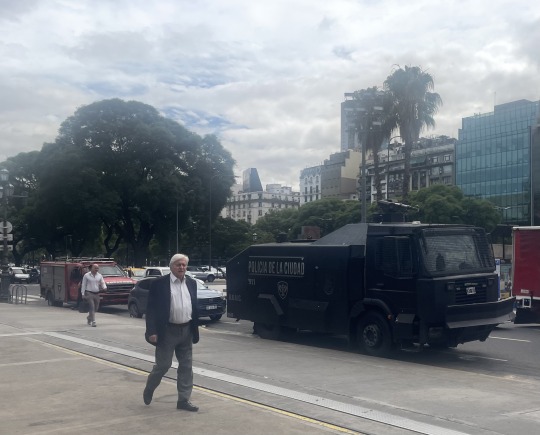
This is one of several police vehicles we saw with a water cannon on top and an ugly looking blade in front.
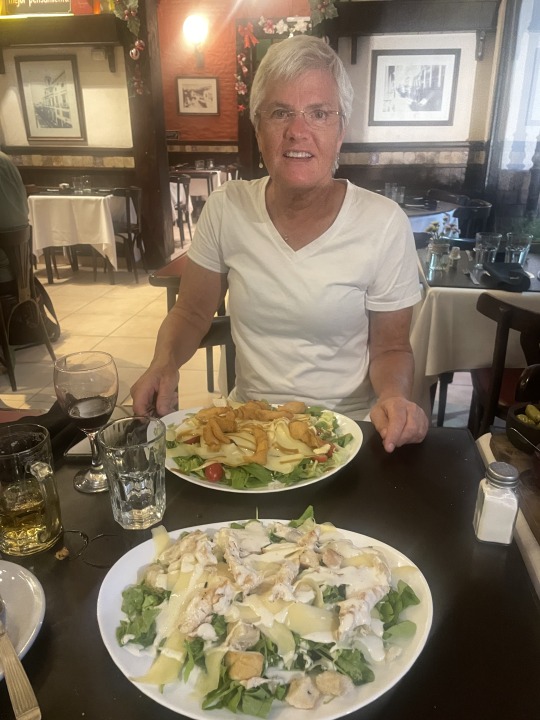
Second night in town we had a much more enjoyable dinner with salads at the Italian restaurant next door. Dinner was great, portions were huge. We had enough left over that the homeless guy outside the front door benefited greatly.
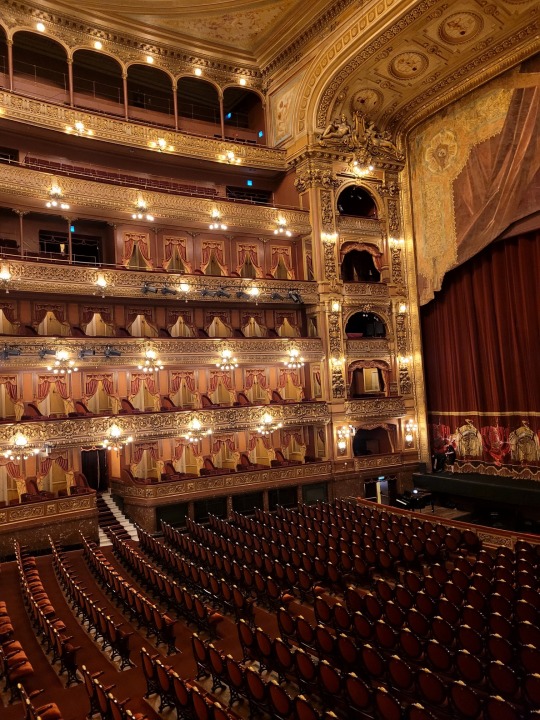
Day three we did the opera house tour. This was a real treat. Completed in 1908 it seats 2,478 people. They brag about how perfect the acoustics are in the building. Every seat at floor level and the box above receive perfect sound.
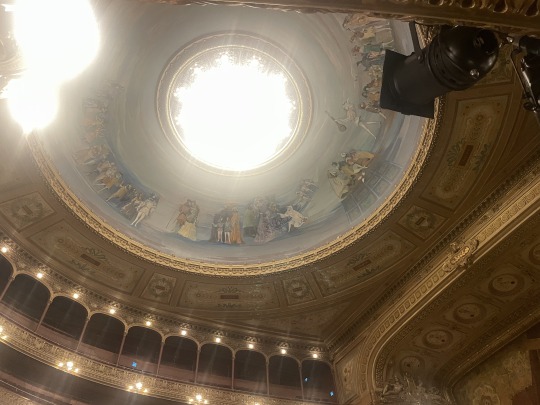
In the ceiling is a 2 ton light fixture. When required a choir of singers stand above the light and sing. Bringing the sounds of heaven alive. Realize this was built before air conditioning.
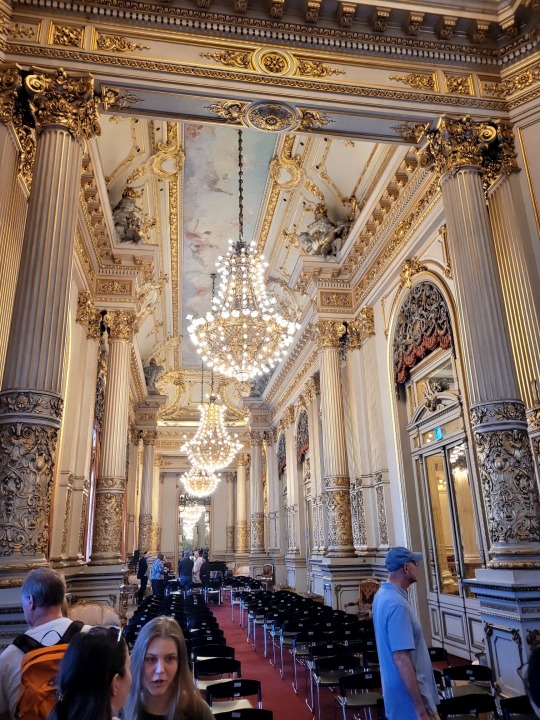
What a beautiful opera house. Again the best of Europe was brought over to build it. Money was no object.
We enjoyed our three days in Buenos Aires, and would encourage others to visit. Wouldn’t suggest venturing far at night.
In the afternoon we changed to the Hilton and checked in for our cruise the next morning.
0 notes
Text
Munich, Germany. Nov. 11-13, 2024

We arrived at the Munchen train station after a 2 hour train trip from Passau. It was a 1 mile hike to our hotel in downtown Munich. We passed by the famous Neus Rathaus (New Townhall) built in 1874. We passed by as the Rathaus-Glockenspeil did its thing on the fifth floor in the 278 ft. tower. The apparatus only does its mechanical merry-go-round and bell chiming 3 times a day. Hundreds of people were shoulder to shoulder watching the show as we walked through the crowd towards our hotel.

Nancy picked a great hotel in a perfect location just off of the main plaza. The Platzl Hotel let us check in early so we could go walk about.

Right around the corner from our hotel was Hofbrauhaus. You haven’t been to Munich, if you haven’t been to the famous Hofbrauhaus (court brewery) in Munich. Established in 1828 by King Ludwig I of Bavaria. Regulars have been Mozart and Lenin. 1920 saw the first meeting of Adolf Hitler and the National Socialist Party here.

Very open and ornate, with communal tables.

Mugs are 1 liter in size.
“Honestly officer, I only had two drinks tonight.”

The different beer houses host their “regulars” who have their own table and personal mugs. The Hofbrauhaus has 3,500 “regulars.” Not uncommon to see them wearing the traditional Lederhosen. This type of gathering is called a, “ Stammtisch” and a sign (see photo above) on their table signifies it is their tabel. (Photo from facebook).

Part of being a “regular” is having your personal mug locked up in your safe. There are 616 such stein safes in the Hofbrauhaus. Some of the steins are over a hundred years old.





As we wandered around the plazas we partook of warm red wine called, “Gluhwein.” Which translates into “Glow-wine”, referring to how you feel after drinking multiple small cups on a brisk December day. When you return your mug you get several euros back.
This is the May pole in the plaza.

Eating our way through the street venders.


Met an Aussie eating a pickle, he highly recommended it.

Pickles, pickles, and more pickles. Big pickles, small pickles, sour and sweet pickles. I think there is a Dr. Seuss pickle book in here!

The mushroom shop next door displaying their stuff.

Sights around town.

The Theatine church of St. Cajetan built from 1663 to 1690 situated on the Odeonsplatz.

This is the Feldherrnhalle monument to the Bavarian Army commissioned in 1848 by King Ludwig I of Bavaria. It was made famous during WW 2, by Adolf Hitler. In 1923 Adolf had started a revolt here and 15 of his group were killed. Adolf was arrested and sentenced to prison after that. When the Nazis took over in 1933, Adolf turned this into a memorial site. SS soldiers were on memorial guard duty here 24 hours a day. Any passerby was expected to give the one arm “Heil Hitler” salute. Many secretly abhorred saluting.


These are the bronze cobblestones on the “Shirker’s Lane.”


We visited this very small but beautiful church. Called St. Johann Nepomuk, better known as the Asam Church. It was built from 1733-1746 by two brothers as their private church. One was a sculptor the other was a painter.

It was darker than most churches we visited but was probably much more ornate. Definitely the smallest.

This was a great treat of mixed hot nuts, served in a paper cone.

Dinner was a spit roasted pork knuckle. I went home stuffed.

Breakfast was these light donut things and good coffee.

This group of regulars were playing music next to us in the back of the breakfast restaurant.

This was a cheese display as well as a huge cheese knife for cutting large cheese wheels. The far end of the knife is fixed with a bolt making a hinge. It is pulled down onto the table, which had many knife cuts in it. Right now the knife is propped up with a piece of wood.
Nancy took in a little spa time the last night in Munich at the hotel. Early wake up with a bag drag to the nearest underground subway. Then a 20 minute train to the Munich airport. One stop before the one way train to the airport, we got caught by the police for not “validating” our tickets. There is a small blue box that stamps a hole in your ticket, who knew?
We promised to leave the country. The police were happy with that.
So ends our Danube cruise, starting with several days in Zurich and ending with two days in Munich. Great trip, great memories!
1 note
·
View note
Text
Danube Cruise, Part 9,
Passau, Germany

A beautiful church on the bank of the Danube. We will pull into Passau, Germany shortly. It is the most visited city in all of Germany. Mainly due to its best preserved medieval town in central Europe. Today there is a population of 50,000 of which 12,000 are students of the University.

Passau is known as the city of three rivers. The river Inn is south of the city. The Danube runs along the north edge of town. From the north the much smaller river Ilz flows into the Danube. Note the three different colors of water. The Ilz is black, the Danube is known as blue-brown. The Inn has glacial runoff and is silvery-grey.

Our boat is moored along side a second ship. To get to shore we head to the top deck and then cross a small gangway to cross the top of the other ship.

Walking into the old town with our guide.

Narrow cobblestone stone streets. Note the building on the left. Not exactly straight or vertical. The city was rebuilt after a massive fire in 1662, built back in the baroque style.

This is one of the prettiest cobblestone streets we saw. The top of the fan design always points up hill. This engineering helps slow down water running downhill.

Munich has a couple of arches between buildings. But it was kind of normal in this town to see this.


On this street were several beer houses that have been in business for centuries.

Our guide and an interesting window design. Just to the right of the window is the flood mark in July 1954. Not to be out done, just above the window on the right is the flood mark March 2013 12.89 meters (roughly 42 ft.).

Several places in town near the river have marks on the wall showing flood levels. Interesting to note the wide range of months they occurred. The earliest recorded flood is 1501 with it flooding into town on an average of every 5 years. The river Inn flows from the Alps and is the source of the floods.


Beautiful architecture. This claims to be the Venice of Germany.

Straight walls?

In the background is St. Stephens Cathedral. There have been churches on this site since 700AD. This church was rebuilt after the 1662 fire.


This church has the second most organ pipes in the world. There are 17,774 pipes and 233 registers. The cathedral has 8 bells, the largest weighs over 16,000 pounds. P.S. All is not what it seems. The organ pipes above are only a picture of the real ones hung on a canvas. The real pipes are out for maintenance for a couple of years.

Note the sun dial on the building to the right. Did you realize that shadows on a sundial mounted on a flat surface in the northern hemisphere, rotate towards the right. The first clocks were invented in the northern hemisphere and the hands are said to rotate clockwise. If clocks had been invented in the southern hemisphere they probably would rotate the other direction.



Many doors in this town are outstanding.

Back to the boat, where we are greeted with warm towels and a fruit drink.

Happy hour, with fellow passengers Sarah and John.

Last nights dinner, everyone departs in the morning.

The Captain gives us a farewell salute. Note the folks in the ship tied to us in the background.

It’s the last night and the ship parties hard. Here Sarah, Heather and Nancy are looking at which song they are going to sing karaoke to. First they sing backup for Keith.

Nancy doing the song “YMCA” with the girls.

We hoof it through town, clanking across cobblestones for 15 minutes to the train station. Here we are crossing the Inn river.

We jump the train to Munchen (Munich) Hbf (Train Station.)
This is the last of our story of the Danube. We spend 2 days in Munich doing the hop-on-hop-off train, and walking around the old town. Drinking at the Hofbrauhaus, eating roasted Pork knuckles, hot nuts from street venders, and sausages.
If you enjoyed these post, we can highly suggest you check out Avalon Tours on the Danube. We traveled on the off shoulder of the regular tourist season Nov. 4-7. Booking two weeks out the price was close to half off. Now we are looking at cruising Portugal’s Douro Valley aboard Avalon’s newest Suite Ship®—the Avalon AlegriaSM. Sailing through vineyards clinging to steep slopes along the shores where 2,000-year-old traditions of winemaking are cherished in the charming villages in one of Europe’s oldest countries. Including a stay legendary Lisbon!
2 notes
·
View notes
Text
Danube River Cruise. Part 8
Linz, Austria.

The ship traveled all night and passed through one lock. We wake up moored at Linz, Austria. Some of the 94 passengers will take a bus tour to Salzburg, Austria. It will be all about the “Sound of Music” and they will be gone 10 hours.

For the morning excursion multiple buses for each of the half dozen cruise ships show up. We all get corralled by color for the proper guide. Nancy and I elect to take a 2 hour walking tour around the historic downtown. We just walk from the ship 5 minutes to the plaza center.

This was a Saturday and a flea market was in the square near our ship. Here is the local Plague monument like so many other towns.
Linz was first a Roman Garrison town reborn as a trading and mercantile center in the Middle ages.

This is the doorway to the tourism office, notice the relief above the balcony. Here they have a large room with a goggle earth photo on the floor that gives a great point of view. Our guide walked all through the city pointing out interesting points.
Note the balcony above the doorway, now check out the following internet photo below. This is very interesting and important as a place Adolf Hitler gave a speech in his home town.

Very chilling to stand in front of this door and think what had transpired in this plaza.

From the main plaza we wonder through the back roads of the town.

Our guide points out one of the 20 Jewish Holocaust memorials in town. These are placed all around town where jews had lived prior to being forced out and possibly killed. There is a working doorbell with the name of the folks who lived there along with the dates of their birth and death. The site in the background was the Jewish Synagogue that was destroyed. This is so timely with the antisemitism that is going on in the world today.

One of the small courtyards off the side of the street. One of the other courtyards we walked through was where Mozart stayed and composed Linzer Symphonie in 1783.

This is the New Cathedral or Cathedral of Immaculate Conception. Plans started in 1855, this Cathedral will hold 20,000 people.

This cathedral still has many of the original stained glass windows. But several were blown out during WW 2. Usually when that happens they are replaced with plain white windows. Here they replaced them with modern stain glass motifs.

There are 7 bells in this cathedral with the largest weighing 8 tons. It is so large it had to be brought down one floor when it was first rung. Because it caused the spire to sway when it was swinging back and forth.
After the guide finished taking us through the cathedral, the tour broke up. Nancy and I found our way back to the ship for lunch.

Nancy has been to the infamous Dachau concentration camp before and passed on this tour. So I went on the two and a half tour of the Mauthausen Memorial myself. This labor camp was 12 miles out side of Linz. Unlike Dachau and other concentration camps that were built to strictly kill as many Jews as it could, this was a labor camp. This was the hub of 49 Nazi labor camps, that provided workers for munitions and arms plants.

Over 92,000 people died here. Most were Polish jews, some were Nazi objectors, but even some English and American airman were imprisoned here. The average life span was 4 months before the prisoners died of malnutrition.

Only a few wooden barracks were still standing.

This was the last concentration camp liberated in WW 2. When the Americans rolled in, 22,000 prisoners were here. The allied soldiers ended up burying around 2,000 prisoners in a mass grave. The prisoners were so weak at that point, they still died even though the camp was liberated. Large memorials are found outside the walls by a dozen countries that had their people killed here. Not what I had expected.
It was a somber bus ride back to the ship.

I would like to say this was the coffee bar in our room. It was actually in the guest lounge in the stern of the ship.

Here Nancy is checking her phone with a cup of coffee in the lounge.

The staff were constantly cleaning the cabins and frequently seen wiping down the walls of the companionway.

This is the center entry way in the ship, looking down from the upper deck of guest cabins. Nancy and Catherine are on their way to morning yoga.

Claudia is running the morning yoga class. Nancy in the foreground.

Meanwhile I visited the gym daily. Notice I didn’t say, “worked out in the gym daily.” Just visited.

Here we are locking through with another ship. This was the first lock we went through during the day, so several of the passengers turned out for the show. The top of the two ships are level with each other. As are the cabin windows. Our Captain warned us at the beginning of the cruise we will be side by side with other ships at time. Beware leaving your curtains open. Apparently the Captain of the other boat did not give the same briefing to his guest. As we pulled along side, everyone in our main lounge viewed a naked women coming out of her bathroom and then diving back in.

A foggy day for sure.

Another interesting church on the bank of the Danube.

Approaching the mouth of another lock. Seems to be some religious statue on the exposed rock.

The lock wall is on the right as we lock through with a second ship. As you can see we only have a couple of inches to spare.

The Captain has dropped the ships bridge down halfway. The ship next to us clears everyone off of the top deck and drop their bridge all the way down. We are still rising up in the lock and will barely pass under the lock bridge ahead.

Here the ship next to us is about to exit the lock. You can see they only a little over a foot of clearance.

Our crew has dropped the awnings covering the top deck tables and chairs.

We successfully pass under the bridge at the lock. We are off to Passau, Austria.
Passau is our all time favorite town on the Danube!
1 note
·
View note
Text
Danube River Cruise, Part 7.
Durnstein and Melk Abby.

Another foggy start to the day. Three swans swim up to our window, to welcome us. Being on the very bottom deck of the boat we were eye ball to eye ball with them. They work along the edge of the boat eating the algae.

We climb to the Durnstein Castle with the help of a local guide. King Richard the LionHeart was held for ransom here in 1192 while returning from the Crusades.

View from the donkey trail to the castle. Durstein is a very, very small village. I believe only 40 local people live here year round. Most shops are owned by outsiders.

Walking into town.

A city gate into the city.

This was a self serve Riesling wine spot on the trail through town. Just put the cash in the tin on top and grab a local wine.

Apricot orchard.



The doors in town had very ornate handles.



We returned to the ship for lunch and a day cruise to Melk. Above you can see Durnstein in our wake.

Countryside is beautiful but it is cold outside.

Warm red wine and breaking out the blankets on deck.

Sharing blankets on deck as we sightsee on the Danube.
Left to right: Christina (England), John and Sarah (retired American pilot and Pediatrician), Nancy and a fellow American passenger.

Beautiful little towns and villages on the banks of the Danube.

More deserts served top side.

Ho hum…Another castle overlooking a small village.

This is one of two car ferries we saw. It is the black thing to the right of the photo. It does not have an engine, but it is attached by a cable tether to a main cable stretching across the river. I believe they just turn the rudder and the current moves them across the river to the other side, as their tether slides along the cable.

Beautiful wine country.

Very small castle perched on the very tip top of a rock.


About to pass another ship going the opposite direction. Passing port-to-port is standard procedure. Due to the curves in the river we are now passing starboard-to-starboard. Besides talking to the other ship and coordinating which side to pass. The Captain has deployed the blue panel with a light in the center, signaling a starboard-to-starboard pass. Once the pass is complete he will stow it horizontally out of sight.

With a quick stop in Melk, Austria we jump on a bus to tour the famous Benedictine Melk Abby founded in 1089.
It is now a coed school with approximately 900 students. We took a walking tour, but are not allowed to take photos in many of the rooms.

So here is an internet photo. Eight pounds of gold were used throughout the abby. The actual cathedral was beautiful as you would imagine.

The library has over 100,000 manuscripts and is a national Treasure. Researchers from around the world come here to read the original manuscripts. The illusionists artist can make a flat ceiling look rounded as above.
Ever walk from one side of a room to the other in front of a huge portrait painted by the Masters. The eyes will follow you and stare directly at you, no matter where you stand in the room. It is called, “The Mona Lisa effect.” It is simply how our brain interprets a two dimensional painted portrait to look three dimensional. The eyes are actually painted looking strait ahead. We just interpret it as looking our way.

This is the ceiling of the “Marble Room.” One of the most interesting rooms, it was the size of a basketball court. The queen would sit dead center in the room and read from the light of a window directly in front of her. When she looked at the painted ceiling above her. It would appear to her that the twenty or so painted gothic columns were reaching up to heaven and the gods. The columns are all angled differently to appear pure vertical when looked at from her chair alone. Here the ceiling is curved but painted to look flat.
While we were at the Abby our ship had continued to Linz, Austria. So our bus drove us to the ship, arriving after dark.
Tomorrow we will tour Linz.
3 notes
·
View notes
Text
Danube River cruise, Part 6. Nov. 7, 2024
Vienna, Austria.
The Danube is the second longest river in Europe at 1,777 miles. Flowing from Germanys Black Forest to its delta on the Romanian and Ukrainian shores of the Black Sea.
Spring time snowmelt in the Alps causes floods of biblical portions.

We wake up to a very foggy morning docked in Vienna. We are moored as the third ship out. When we leave for our tour today we actually walk through two other ships to get to shore. One was the sister ship to our boat, the other was a more prestigious TAUCK cruise lines ship.
Vienna obviously has a tremendous amount of history and culture, but it is also a very modern and large city. So it was not that easy to just meander around old small streets, directly from the ship. So although impressive it just wasn’t a favorite stop of ours.

Tour buses pick up each of our groups. I am assuming almost all 94 passengers took the morning tour into town. Plus there are half a dozen other ships here needing buses.


This is the Parliament building.

Gate entrance with a Hercules sculpture.

More gates with Hercules saving the city.

This is a baroque monument to the ending of the Great Plague Epidemic of 1679. The “Plague Column” or “Trinity Column” has Emperor Leopold in the center praying to the gods above to end the plague. The sculpture of Leopold shows his genetically deformed lower jaw. Which was due to inbreeding of the Kings and Queens of the time. It was better to intermarry between the leaders of countries than to fight wars.

This is St. Stephan’s Cathedral completed in 1578. It is oriented to the sunrise of December 26 the birthday of St. Stephen. The tallest spire stands 447 ft. high. When the Germans retreated during WW2, orders were given to shell it 100 times and reduce it to rumble. Luckily the local Captain, Klinkicht, disregarded his orders.

The massive front door is called the “Giants door”, possibly due to a Mammoth’s thigh bone that was hung over the door originally. The bone was found when initial excavations started in 1443.

The insides of these Cathedrals are just spell binding, and photos do not do them justice.


The Cathedral has 22 bells and over 12,000 organ pipes.

As we walked around town, we came across Mozart’s house. Sigmund Freud did his studies in Vienna.

I took the afternoon off, while Nancy went to the 1,400 room Schonbrunn palace by bus. The Captain gave me a tour of the wheel house. All of his computer displays for navigation are below the counter height because the top half of the wheel house can be dropped down to just above the counter. There is even a hatch above his head that can be opened up for him to drive the ship, with his head and shoulders above the roof.
Note the carpenters level on the front of the counter. He can balance out the boat moving fuel and water around. Attention to detail! Wouldn't want the doors below swinging open.

Nancy at, Schonbrunn, the summer palace of the Hapsburg Empire. This was built to keep up with the Joneses. It was to rival Paris’s Versailles.




Happy hour was an hour earlier today so we could attend the opera.

We attended a show of classical music and opera at the Vienna Opera House. The “Blue Danube Waltz” was written by Johann Strauss, the younger, at the age of 42. He was Viennas most popular composer playing the Blue Danube Waltz for the first time in February 1867. It is the unofficial anthem of Vienna.
This concert was just a sliver of music, opera and dancing all done with humor and gaiety. Our fellow passenger, Christina, who works for the London Philharmonic and attends many concerts was not impressed. But, when in Vienna you have to go to a concert!


The operetta singer.
When we wake up in the morning we will be docking at Durnstein, Austria.
1 note
·
View note
Text
Danube River Cruise, Part 5. First day traveling by ship, Bratislava.

This is the Parliament building in Budapest all lit up as we start traveling all night.

Looking astern the city of Buda under a crescent moon.

Crossing under the “Chain Bridge” crossing from Pest to Buda.

Looking out the back of the ship from its small inside lounge.

We had cruised all night around 11 kts heading upstream. We are now in Slovakia, with the Slovakian courtesy flag flying from the right side of the radar mast. We will stop early enough in the day to do a tour of the next city before lunch.

First stop is Bratislava, the Capital of Slovakia. Bratislava is the fourth largest town on the Danube with a population of 500,000. We dock next to the old downtown where we walk with our “Adventure Host”, Claudia, to the Bratislava castle overlooking the town. Each day you can sign up for a tour by a local guide or go with a crew member, called an “Adventure Host.” The Adventure Host shows you the way to get someplace, but does not give any commentary such as the history. Claudia did all the Adventure Host tours either climbing to a castle or biking 21 kilometers. Claudia also leads the yoga class every morning.

This castle was pretty much a bust. Truthfully, it was only advertised as a great view of the city. But we later toured the old town which was very unique and fun to walk the streets.

This is Saint Martins cathedral, where 11 Hungarian Kings and 8 Queens were crowned. This city has been on the map for centuries prior to the Romans taking it.

Nancy found this sculpture of a man at work (see top of photo) and rubbed his hard hat.

Typical carriage entrance leading to a courtyard. The entrances where horse carriages drove through always have large “Guard stones” protrusions at the base. Protecting the walls from the carriage axle hitting it and damaging both the carriage and wall. In some countries they are now even protected by law.

One of several churches we visited. This one was unique because the figures were not adorned in gold. They looked like silver. Note all the figures in the churches look like they are made out of solid gold. They are actually hollow wooden forms with gold leaf applied. As ornate as a large cathedral is they may only use 3 pounds of gold.

This was the pulpit in the same church. Just so ornate! Most are dark wood, so this caught our eye.
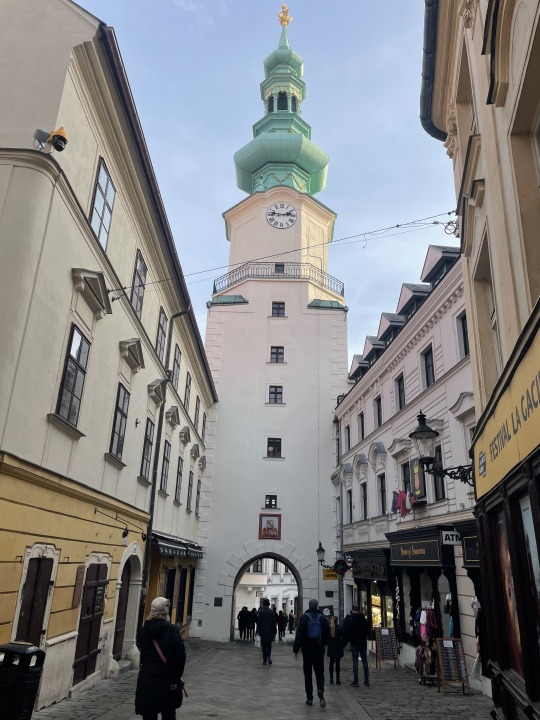
This was a city gate back in the day.

Hard to see in the photo but at the top corners above the doorway are the sheeves where the ropes ran through to raise and lower the draw bridge across the moat. Once we figured this out we were able to identify them at other castle entrances. The moat has now been filled in. Just imagine Kings and Knights riding their horses into the city through this same gate.

Back to the ship for lunch and drinks before exploring the old city again. At each stop the lunch or dinner on the ship represents the local culture. This is Slovakian Goulash on rice with pasta, Nancy has a light soup with wine. I think we walked every single winding road and ally in the old city. Only one church was locked, but we toured 3 or 4 others.

This is a monument to the Plague built in 1713. Monuments to the Plague were very common in the towns we visited.


There are a few “fixer-uppers” available in town. On the left is the most ornate “guard stone” we saw on the trip.

The city plazas were busy with Christmas market stalls being built. Several different embassies to Slovakia were in the buildings around the plaza.

Another curving ally covered in large cobblestone. Note the guard stone fender on the left side of the ally.

This is the city gate the King rode through on his way to the coronation.

The doors were just beautiful, you don’t see anything like this built today.
1 note
·
View note
Text
Danube River Cruise, Part 4
Still in Budapest

Still doing walk about. So much to see and do in Budapest. This is their “Funnel Cake.” This is common street fare.

It is dough wrapped around a metal form and then turned over a charcoal fire. As it cooks it is periodically moved closer to the heat. Two different shapes. The one becomes a cone and can have ice cream placed in it. Mine was the “classic”, which is tube shaped, with Nutella chocolate smeared on the inside. They forgot the coconut on the outside. I think they all go through a sugar bath after cooking.

We were looking for this “Street Market” which was next door to the little food truck stop where I bought the funnel cake. The Street Market was not a Farmers market which we were expecting. Save your money on a “Bad acid trip” and visit this place.

Multiple bars and a couple of open air shops. Two floors of what you would expect to see in an opium den. A cross between Bourbon Street and Key West. I am sure it is wild at night.

This is the “Great Synagogue” in the Jewish District. Surprisingly we only saw a handful of Hasidic Jews in the district. Second largest synagogue in Europe. Lots of history and not all good. It did survive WW 2 fairly unscathed. But its people did not.

This is inside with our English speaking guide giving his talk. Very ornate. All men had to wear a yamaka. So they gave us a paper yamaka with a bobby pin. With my short hair, I more or less balanced it in place and held it on when outside in the wind. The bald guy really had problems.

This is a reminder of the Jewish hostages held in Palestine. We have seen much graffiti starting in Zurich and here of “Free Palestine” with some fighting back by the Jews. It has now been a little over a year of captivity for the hostages.
The Jewish faith forbids bodies to be buried near the synagogue. Yet there are over 2,000 bodies buried in the courtyard here. All were killed and left in the street at the end of the WW 2. Allied forces quickly buried these here in mass graves. Only half have been identified. It is also forbidden in the Jewish faith to exhume or move a body. So they are a grim reminder of what has transpired in the past.

From the Jewish synagogue we visited St. Stephen’s Cathedral. I need to specify it is St. Stephen Cathedral in Budapest. We visited several others with the same name in different cities. The largest Cathedral in Budapest. I would like to formally post my objection to the building of such tall Cathedrals. I can not get them in the photograph without it warping the image. I also have to strain my neck to see the spires and the ceilings inside.

Pictures just do not do these houses of worship justice. So much symbolism and artistry everywhere.
The Cathedral is named after King Stephen founder of the state. He died in 1038 and was later Canonized.

Before heading back we stopped by for a pint of Guinness. Which reminds of us Neil and Beverly and our trip through Anglesey, Wales.

Having a traditional Hungarian dish of pork knuckle. I can highly recommend it for meat eaters in the crowd.

Desert of caramelized strudel.

This is the after dinner drink of the local moonshine “Palinka”, no open flames please.

Next morning we toured the Parliament Building. It is so big you can not get it all in the photograph from street level. You will see the whole thing lit up when we depart on the ship the next night.

This is looking back at the front door. Unfortunately there are very few places where we can take photos inside. We saw the gold Crown studded with gems, protected by two soldiers at all times.

This is equivalent to the Senate floor. With students receiving a lecture at the time.

This is a monument of 60 pairs of shoes. Symbols of the 15,000-20,000 Jews who were required to remove their shoes, prior to being shot and their bodies dumped in the Danube. This happened during 4 months in WW 2. The shoes were considered valuable at the time.

After checking out of the “Hampton by Hilton” we took the subway to the ship. Budapest boasts about it being the second oldest electrified subway in Europe, opening in 1896. The strange thing is after buying your very small ticket above ground and riding the subway. It is not until you try to leave that you have to find the very small paper ticket in one of many pockets. Two very tough looking women, probably prior East German border guards, caught the women behind us.

We find our ship Avalon Illumination (warned: don’t call it a boat) at Dock 6. The cruise line is Avalon, which has been in tourism for 100 years. They supply us with an app that gives us all the information we need. Including the time and quickest way to find the ship if we are walking around town.

This is our sea cabin. We drop our bags and head back into the city.

We cruise through the large market two blocks away. Food stalls are on the first floor. Souvenirs and such on the upper floor. I buy some pork rinds.

Nancy finds a man with a chicken. He would not answer which came first, the chicken or the egg.

These are small pastries filled with different fillings. Walnut paste was the classic. It was a bit dry but very popular. The meat shop next door had every part of a duck on display.

This shows just how big the market is. So many people selling the same souvenirs or food, you wonder how they survive.

Back to the ship for our first night onboard. We get our safety brief and meet the Captain and crew. In an emergency we are all supposed to meet on the top deck. The Danube is so shallow there is a good chance the boat would sink to the bottom and we would still be 10 feet above the water drinking our beer and wine.

Nancy and I passed up the tours that the ship set up since we had already toured the city for two days. Instead we did a walking tour with a local woman who was passionate about history. The walking tours can really get into the specifics. This courtyard had just about all the architecture styles: Baroque, Gothic, neoclassical and neo-ugly. The far building was bombed and replaced with bland architecture, which our guide aptly labeled as neo-ugly.
This is the last day of us walking 5-7 miles a day with quick stops by the hotel room. Tours on the cruise are much less. Definitely trying to walk off as many calories as we can. So much to eat and see!

This is the “Chain bridge.” The chain refers to the links between the vertical columns. The chains are like huge bicycle chain links. Very ornate and the only bridge from Buda to Pest for years. Originally open in 1849 and one of the largest bridges in the world at the time. The bridge was destroyed by retreating Germans in 1945 and reopened 1949.
Back to the ship for our embarkation at 5:30 and sailing upstream to Vilshofen, Austria.

They dock up to 3 boats side by side. This is the bow of a second ship tied along side. We left first. So they untie from us and they move back and out a little. Then we untie from the shore, and pull ahead. They immediately retie to shore at the same dock. These guys make it look easy.
3 notes
·
View notes
Text
Danube River Cruise, Part 3. Budapest for 2 days prior to the ship.

We survived the train ride to Budapest. The ride from Wein had a homeless woman latch on to us. She tried to ride the first class car with us, even though she did not have a ticket. They threw her off the car at the next station. Nancy and I had a 6 seat compartment to our selves. At least these seats reclined enough we could sleep for a few hours. Above is Nancy at the Keleti train station in Budapest. We thought the hotel was a 5 minute walk away. Except there are two train stations in Budapest, this was not the close one. Today’s technology gave us a map with walking times on Nancy’s phone. So for 23 Euros we put our lives in the hands of a maniac taxi driver. We at least learned look way, way down the road before crossing as a pedestrian. I believe he may have been a retired Formula One driver.

Took this photo to recognize our street corner on the way back. Downtown Pest is very ornate and rather beautiful. Did you catch the fact that this is “Pest” and not “Budapest.” Turns out “Buda” is the other side of the Danube. They are referred to as one word “Budapest”, but they actually started out as two different cities. It is pronounced, “Buda-Pesh.”

Our hotel is a 5 minute walk to St. Stephen’s Cathedral. Here we hoped on the “Hop-on-hop-off” bus. A great way of riding around the city for an hour and getting acquainted with what is where. We bought the 24 hour pass.

Kunsthalle Hall of Art across from Hero’s Square.

Just a small part of Hero's Square. You just cant get it all in the picture.

This is a beautiful eclectic Castle/Church/Museum called, Vadjahunyad behind Hero’s Square. They purposefully incorporated several different castles from Europe into this one structure. It actually worked out very well.

Here we are crossing a symbolic mote and approaching the main gate. Cypress tree on the right is turning colors with a vendor in front of it selling Hungarian red wine and pretzels. A small charcoal fire was under the pot of red wine.

Jaki Chapel inside the Castle grounds.

Statue of “Anonymvs.” The statue of the hooded figure opposite Vajdahunyad Castle is that of Anonymous, the unknown chronicler at the court of King Béla III (r 1172–96) who wrote a history of the early Magyars. Note the pen with the shiny tip in his hand; writers (both real and aspirant) stroke it for inspiration.


Monument to George Washington. Very strong relations between the two countries for decades.

Desert and Hungarian Coffee at the famous New York Cave Budapest. Voted the most beautiful cafe in the world. Very rich coffee with honey, cream on top and a few raisins sprinkled on top of the cream.

This is inside the cafe. It could be a palace. Always a line outside.

The New York Cafe.

We took the hop-on bus over to Buda on the west bank and explored the Turkish Bath house.

Statue at the far end of the Gellert bath. You can buy slippers and are required to use a bathing cap.

More of the Gellert Bath hall. About 8 different bath houses. One had a two story bath with it opening to the sky on a street corner.


On top of the Citadel with the horse ring in the building behind the statue.

Beautiful statues outside the museum on top of the Citadel.

Entrance to the courtyard of the Museum.

View looking North East across the Danube with the “Chain Bridge” in the foreground and Parliament left of center.

The funicular car climbing the hill. We were crossing a bridge above it halfway to the top.

We took the hop on bus early the next morning while we could get to places we couldn’t easily walk. We jumped off in Buda and explored this 18th century baroque church.

This is the opera house lobby.

This is the front of the opera house where the less worthy people entered. The elite used the side door.

This is Nancy in the underground train station for the Opera house.
1 note
·
View note
Text
Danube River cruise, Part 2. Zurich day 2.

After a nap we walked back into the old part of Zurich for dinner. Crossing the many bridges gives you a unobstructed view of the buildings. The swans were still feeding after dark.

Cheese fondue with morel mushrooms is phenomenal. Items to dip in the cheese are chunks of bread, small potatoes, pickled onions and best of all pickles. Second coarse was a rosti (hash brown) and sliced lamb with a mushroom sauce.


Just wandering around the city which is very safe.

Interesting 15 th century Tavern.

Not many wooden buildings.

This fountain is near the Cathedral, hence its motif.

A back ally bar.

Carriage at the museum.

Nancy with Heidi the cow.

Similar to Amsterdams 3 dimensional plaster figures on the building. This is a painting indicating to people who could not read what is sold here. This was a cobblers business back in the day.

Another example of a business advertisement is the double painting on the corner of an old printing shop. The words on the left say, “Book Printer.”

Nancy getting a sip from the “snail fountain” on Frog street. Someone had lined the top of the fountain with snail shells.

This is “Frog Street” several shops sold frog souvenirs.

Here a very wide fountain was made more user friendly by the first spout pouring into a funnel. Which has supported extension spout pouring the water out closer to the edge of the fountain.

The tops of the chimneys had small designs looking like little houses.

The Swiss knock off of Kentucky Fried Chicken.

We took the funicular car to the top which is where the University is.

View from the University level.

One of the University buildings.




Another example of colorful shudders.

Large water fountain with the Blue and White flag of the city of Zurich.


This was an observatory in town. The wind vane had the sun and moon symbols.

Classic Swiss lunch of Mac n’Cheese but you spoon in dollops of applesauce which sweetens it up. Again this is not Velvetta cheese.

Waiting at the train station looking for the gate number.

First class car for our trip of eleven hours to Wein (Vienna). Only a few people on the trip. We were looking forward to a beautiful ride through the farmlands of Switzerland. Unfortunately the windows were pretty dirty preventing photos. Worst of all the chairs did not recline at all. Making the trip horrible. It was a very fast train averaging 90 mph. Coming down hill from Innsbruck we were doing 136 mph. Barely felt the train moving. We arrived in Wein at 0140 in the morning. They closed down the train station and kicked us and the homeless out in the cold. Hotels were full. Drunks were screaming. Cold biting wind was blowing. Lucky for us we found a 24 hour bar and moved in for 4 hours.
4 notes
·
View notes
Text
Danube River Cruise 2024, Part 1. Day 1 Zurich

Flew out of MIA Wednesday Oct. 30, 2024 for Philadelphia. After a 9 hour wait we boarded the 7+ hour flight to Zurich Switzerland.

We lucked out and got the last 2 First Class seats. Arriving in Zurich at 0840 on the 31st. Just walk across the street at the airport and take a 5 minute train to the main train station in Zurich. The main stations are called HBF’s. For 30 euro we took a taxi from one side of the train station to Fred’s Guest House, on the other side of the train station. Which if we had walked out the other side of the train station is a 3 minute walk. But it was a safer bet to use the taxi.

Super nice staff at the hotel. Typical European hotel, very small elevator. Fitting in two Americans and their bags is almost an impossible feat.

After dropping the luggage in the room, we went walk about. The old part of the city is between Lake Zurich and our hotel near the train station.

This will be are stomping grounds for 30 hours. Just a little over a mile top to bottom. We end up walking about 7 miles the first day with a nap in between.

Old Zurich is known for its water fountains. Yes, the water is safe to drink. If you look to the left side at the base even dogs get to drink the water. Each fountain is different; some ordinary, some very ornate. Unless there is a particular theme for what is near by, the old standby is the lions head. This has an Anchor on the front. We are pretty close to a river and small marina. Note the two metal bars across the fountain under the water spout. Every old fountain has them. Can you guess why?

The Swiss drive on the right hand side of the road which makes it easy for us. But the Electric trams are everywhere. Bikes have their own lanes. We were able to figure out, when there is no stoplight, but there is a crosswalk. Trams, cars and bikes all give way to the pedestrian. You just needed to know whether there was a stoplight or not.

Look at this government building from 1917. Slate roof with a twist. Two cornucopia and a clock on the front. You have never seen so many clocks and advertisements for watches until you visit Zurich. Have you ever noticed every watch advertisement has the hands roughly at 10:10?

Wrought iron balconies are common. Majority of older houses are 4-5 floors. Common for a business to be ground floor and then apartments above. I doubt many have elevators. No fat Swiss.

End of a bridge across one of the rivers running through town. Very ornate lamps with a metal Lion sculpture on top.

Many of the really old houses paint their shudders in a one off design and color. I assume it was to facilitate people finding the address. You can see these from several blocks away. Pay attention to the photos below.

River cruise boats on Lake Zurich. Originally these were paddle wheelers. Not sure if the wheels work now or not.

Swans and seagulls being fed from the Quaibrucke (bridge). Fall colors still.

Looking across Limmat river.

Several of these were around town. I will give you a hint why in the next photo.

Bikes parked at the train station. Several hundred if not a thousand bikes around the station. One of many bike parking areas here. The previous photo was of a bike cycle pump.

No straight roads. Green shudders on the house.


Fish fountain with the Limmet river on the other side of the wall. Since there are no iron bars across the water you can tell it is a modern Fountain.

This is a door to the only church we went in. The inside of the church was fairly plain. The stain glasses were nice but not as picturesque as many of the churches we have been in.



Typical cobblestone side street, pedestrian only.

Old fountain (see the bars), water spewing from the lions mouth. I am sure there is story behind the old guy on the top reaching into the mouth of the lion.
Have you figured out the metal bars supported the pots people would put under the spout, then slid it back to the edge. Before carrying it home.
Look at the ornate building on the left.

This is viewing the Hotel Storchen (Hotel Stork) from across the Limmet River. They have a small platform you can bring a boat up too. On the roof to the right side is a sculpture of a mother stork and her baby in a stick nest. The church steeple in the center is for St. Peters church behind it.

Check out the nest on the top of the building.

The boss and the guy with the level were on vacation when the roof was built. Hope the home owner got a discount.

Roasted chestnuts, 4 euros. Heading back to Fred’s Guest house for a nap!

Fred immortalized on the side of his guest house. I think he got the idea from Conrad Hilton. Note the slightly open window on the building to the right. Nancy opened our window. The top fell into the room 6 inches. We thought she broke it.
5 notes
·
View notes
Text
The Bahamas 2024, heading home Part 7.

Time to start working our way home. About 345 nautical miles, little to no sight seeing along the way. We refuel at Salt Pond, Long Island. Then spend one more night at a remote anchorage in Grey’s Bight Long Island, near the blue hole.

I collect 5 sheepwool sponges, and clean them everyday. The first couple of days are the worst. They stink and the flies are thick. So we leave them in the dinghy. Tailwinds are a problem heading downwind. Each day I change the water and squeeze them multiple times to clean out the organic material.

Heading up Comer Channel seas are flat. But the wind is forecast to pick up. We anchor behind a very small island on the back side of Great Exuma. Winds will be blowing from the East for the next couple days. But we can hide from the worst of the waves behind the Exumas and not burn fuel motoring.
We run 100 miles up the Exumas and then top off at Staniel Cay Yacht Club.
Buy the time we leave Normans Cay for our run to West Bay New Providence winds have died down making an easy crossing.

One night in West Bay. Weather window is holding for our crossing of Tongue Of The Ocean (TOTO) the next day.

Three dolphin send us on our way early in the morning.

Near “the pocket” of TOTO, fish are abundant. We cross paths with three Short Fin Pilot Whales, in the photo above. More than likely they are young males. As you can see seas are flat for a nice crossing. We will anchor on “the Bank” in 20 feet of water after a 75 mile day. We will hide from boat traffic on the back side of Mackie Shoal.

Above is the wreck of the Hesperus on “the Bank”, east of Bimini.

This is North rock just off Bimini, looks like a submarine with a periscope.

This is Radio Beach Bimini. Normally a great place to anchor out of the swells. With easy departure before daylight to cross the Gulf Stream. With the recent addition of cruise ships bringing tourist. A jet skies concession has opened up. So they were flying around. But at sunset things settled down.

Sunrise in the Gulf Stream with freighters passing behind us. Several hours out we hear a May Day call from a private vessel with a fire in the engine room. US Coast Guard could not hear them, so I answered them. They had lost all power. USCG could hear us, so we relayed information between the two. Fire was out, but they were adrift and required a tow.

We had a great crossing with calm seas and entered Biscayne Bay at Stiltsville. About a dozen weekend party homes still left. Turn down Biscayne Bay and check in with US Customs via their app. All goes well and we are cleared in to the country with out having to go to their office.

Once I get the above message it is a huge relief for me. People sometimes have to jump through some major hoops. Or even pay huge fines if they mistakenly bring in a food item. We end up anchoring for the night in the bay near Ocean Reef. Several dolphins cruise by at day break. We cross to the ocean but can only make 2 knots without overheating the engine. After anchoring behind Tavernier Key, Nancy finds a huge ball of seaweeed wrapped around the prop.

After we got home and prepared the boat for Hurricane season, I disassembled the heat exchanger on the engine. This is part of the reason the engine was overheating. It needs to be serviced every 1,000 hours.

This is the hose leading into the heat exchanger. The black oblong thing in the center is the only area the water could come through the rest is calcification. Had to throw out this hose and give the heat exchanger an acid bath. Ready for next years Bahamas cruise.
1 note
·
View note